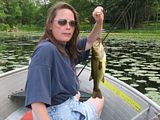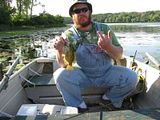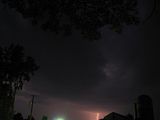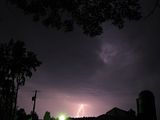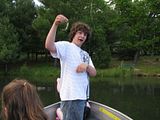Yes sir, we live in Wisconsin! Two days ago I had sweat running down the crack of my ass, tonight there's a fire in the stove. That's ok, I prefer cold weather over hot weather any day.
- Quads, hailing from Grand Marsh Observatory atop Elk Castle Hill
Tuesday, June 30, 2009
Phoenix crop circle may predict end of the world
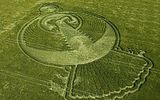
The 400-foot design was discovered in a barley field in Yatesbury near Devizes and depicts the mythical phoenix reborn as it rises from the ashes.
Investigators claim more formations are referencing the possibility of a cataclysmic event occurring on December 21, 2012, which coincides with the end of the ancient Mayan calendar.
The Mayans believed civilisation exists within a series of earth cycles of 144,000 days each with the 13th expiring in December 2012, resulting in Armageddon.
Crop circle enthusiast Karen Alexander, from Gosport, Hants, said: "The phoenix is a mythical creature which symbolises rebirth and a new era in many cultures across the world.
"Within the crop circle community many believe the designs are constantly referring to December 21 and its aftermath.
"This could be interpreted as the human race or earth rising again after a monumental event.
"The patterns are becoming more intricate with every find and it is exciting to think how they are going to evolve by the time we get to 2012."
Recent crop circles have included giant jelly-fish and one image discovered in Wiltshire in June which experts dubbed the most 'mind boggling' they had ever come across.
The formation, measuring 150ft in diameter, is apparently a coded image representing the first 10 digits, 3.141592654, of pi.
source....
The Trifid Nebula
The Trifid Nebula is in Sagittarius, which is low in the southeast in early evening. Its brightest stars form a teapot shape. The Trifid is just above the spout of the teapot. Photographs of the nebula show three red and blue blobs of gas.
- Quads, hailing from Grand Marsh Observatory atop Elk Castle Hill
- Quads, hailing from Grand Marsh Observatory atop Elk Castle Hill
Monday, June 29, 2009
News From The Observatory
12 Twisted Tornado Facts

With spring coming to a close, tornado season is winding down. And this one had been a dud.
Though the season has been less active than those in recent years, more than 800 twisters are estimated to have touched down across the United States so far this year. And while conditions for the rest of the year won't be as favorable to tornado formation, these storms can whip up a twister at any time of the year.
Despite improved warnings and forecasts over the past few decades, tornadoes still cause many deaths each year. To learn a little more about these violent storms, here are 12 facts that illustrate how destructive tornadoes can be, where they can occur and how to prepare for them.
1. How do tornadoes form?
Tornadoes form where warm moist air is trapped underneath a layer of cold, dry air. This instability is upset when the warm bottom layer gets pushed up — either by heating near the ground, or by an influx of cold air.
As the moist air rises, it cools, forming clouds and thunderstorms. If the conditions are right, the rapidly rising air will spin around a central funnel, at speeds sometimes exceeding 250 mph. A tornado technically is born when this funnel cloud touches down on the ground.
Although tornadoes are more frequent in the afternoon, they can happen anytime, even at night.
2. Where do tornadoes form?
Tornadoes can occur almost anywhere in the world, but the United States is the country with the highest frequency of tornadoes. About 1,000 tornadoes hit the United States each year.
Twisters strike predominantly along Tornado Alley — a flat stretch of land from west Texas to North Dakota. The region is ideal for tornadoes, as dry polar air from Canada meets warm moist tropical air from the Gulf of Mexico.
3. Do tornadoes occur only in the spring?
While tornado season — the time of year that historically produces the most tornadoes — runs from early spring through mid-summer, tornadoes can happen any time of year if the conditions are right. Essentially, this is any time when warm and cool air masses collide.
4. What state gets hit by the most tornadoes?
That would be Texas, which averages 125 tornadoes every year. Oklahoma comes in next with about 57 tornadoes per year, with Kansas and Florida following close behind with 55 each. Florida of course is much smaller, and therefore has more twisters per square mile than anywhere else.
5. What month has the most tornadoes?
May is typically the month in which most tornadoes occur, followed by June. The record for most tornadoes in any month (since record keeping began in 1950) was set in May 2003, with 543 tornadoes confirmed in the final numbers.
6. How much damage can tornadoes cause?
That all depends on how big the storm is and how fast its winds are whipping around.
The Fujita scale, named for the scientist who developed it, ranks tornado strength based on the damage they cause. The scale runs from F0 to F5; the most violent tornadoes, F4 and above, account for less than 1 percent of all tornadoes, but account for 70 percent of tornado-related deaths.
These terrifying twisters can level a house and lift up a car and fling it 100 yards away. F2s and F3s can tear off roofs, destroy mobile homes and lift cars off the ground. F0s and F1s will break tree branches, damage signs and take off a few roof shingles.
7. What's the difference between hurricane and tornado damage?
It's mostly a matter of scale. Tornadoes have much higher wind speeds, so most of the damage wrought by them is wind-related. But they are much smaller and so cause damage over a smaller area than hurricanes. Most damage from hurricanes comes from flooding and storm surge.
8. What was the deadliest tornado outbreak?
The deadliest outbreak came on April 3, 1974, when a two-day "Super Outbreak" of 147 tornadoes killed 308 people in 13 states.
The deadliest single tornado was the "Tri-state" tornado that killed 695 people along a 219 mile long track across parts of Missouri, Illinois and Indiana on March 18, 1925.
9. What city has been hit by the most tornadoes?
Oklahoma City has been hit by a staggering 100 tornadoes; the earliest recorded tornado there was in 1893. The most-hit city count can change based on how city limits are defined, but when considering a 20-mile radius around a city of 100,000 or more, Oklahoma City is in the lead, followed by Huntsville, Ala.
10. What is the highest elevation a tornado has occurred at?
This isn't known for sure, but scientists with the National Weather Service say it is at least over 10,000 feet above sea level.
The NWS website lists a tornado observed and photographed by a hiker at 12,000 feet in Sequoia National Park, California, on July 7, 2004, as the likely candidate for highest elevation tornado known.
The highest altitude ever recorded for a violent tornado was between 8,500 and 10,000 feet elevation in Wyoming — an F4 tornado struck there on July 21, 1987.
11. How do I prepare for a tornado?
Keep abreast of local weather forecasts and listen for watches and warnings. Having a weather radio in the house is also a good idea.
Have a family plan in place so you can quickly find shelter. Basements and storm cellars are the best place to take shelter, but if you don't have either one, head to a bathroom, closet or any other interior rooms away from windows.
Don't bother opening windows to equalize the pressure in the house — it's a waste of time and the tornado will take care of that for you if it does hit your house.
If you're in a car, get out and head for sturdy shelter or a low, flat spot. Don't take shelter under a bridge, which is highly dangerous.
12. What's the difference between a tornado watch and a tornado warning?
A tornado watch defines an area (usually displayed on meteorologists' maps) where tornadoes and other kinds of severe weather are likely in the next few hours. If you're in such an area, be alert.
A warning means that a tornado has been spotted or that radar has shown circulation in a storm that could spawn a tornado. Warnings mean you should seek shelter immediately.
source....
Moon is visible during the day
Contrary to popular belief, the Moon is visible during the day as well as the night, and the next few afternoons are a good time to look for it. Today, the Moon rises around mid afternoon and is low in the south by the time the Sun sets.
- Quads, hailing from Grand Marsh Observatory atop Elk Castle Hill
- Quads, hailing from Grand Marsh Observatory atop Elk Castle Hill
Sunday, June 28, 2009
ISS Tomorrow Morning
29 Jun -2.6 02:24:01 N 54
- Quads, hailing from Grand Marsh Observatory atop Elk Castle Hill
- Quads, hailing from Grand Marsh Observatory atop Elk Castle Hill
The Big Dipper
The Big Dipper is in the northwest late this evening. The bowl is below the handle, as though it were pouring water onto the ground below. As you watch during the night, though, it will "refill" itself as it dips low across the northern horizon, then begins to climb back up into the northeast.
- Quads, hailing from Grand Marsh Observatory atop Elk Castle Hill
- Quads, hailing from Grand Marsh Observatory atop Elk Castle Hill
Believe It or Not, a Shortage of Oddities Bedevils Ripley's
After 34 years of labor, Scott Weaver, a 49-year-old manager in the produce department of Lucky Supermarket in Rohnert Park, Calif., finished the model of San Francisco he had constructed entirely of toothpicks.
At the Sonoma County Fair, the sculpture won rave reviews -- not least for the built-in track that allows ping-pong balls to roll past city landmarks.
In Florida, Edward Meyer, vice president of exhibits and archives at Ripley Entertainment Inc., noticed a YouTube video of the sculpture. He dispatched a local employee from the Ripley's Believe It or Not! Museum in San Francisco to offer $10,000 on the spot for the piece.
Mr. Weaver wasn't selling.
In March, Mr. Meyer tried calling Mr. Weaver directly to double the offer.
And again, Mr. Weaver said no.
"Right now, it's my holy grail," says Mr. Meyer, who upped his offer to $40,000 in April, without any luck.
Mr. Meyer spends much of his time pining for objects like Mr. Weaver's toothpick sculpture. These are what in Ripley's parlance are called "A exhibits" -- those odd, one-of-a-kind, often interactive items that can anchor the rest of a museum collection.
Over the past four years, Ripley's Believe It or Not!, a unit of Jim Pattison Group's Ripley Entertainment Inc., has been on an expansion binge. It opened big new museums in New York, London, San Antonio and Bangalore, India. Four more are to open by mid-2010, in Veracruz, Mexico; Bahrain; Jeju, South Korea; and Surfer's Paradise, Australia.
As a result, the company says, it is for the first time in its history facing a shortage of A-list oddities on par with the portrait of Barack Obama made of 12,000 gum balls in New York, the three shrunken heads on display in London and the vampire-killing kit from the mid-1800s at the Tennessee museum.
"We have 10% of what we had just two years ago" because the company's stockpile has been nearly emptied to fill the new museums, says Tim O'Brien, vice president of communications at Ripley Entertainment. "We are in search for at least 200 A exhibits to replenish our supply and meet our current needs," he says.
But finding and buying large amounts of weird art, shrunken heads or Hollywood memorabilia while staying within budget isn't easily rushed.
Consider shrunken heads. Every Ripley's museum must have one, and private collectors still covet them, but so far as experts can tell, no one is still making them. Mr. Meyer says that when he started working in acquisitions at Ripley's 31 years ago, the preserved human heads slightly larger than a fist could be bought for between $500 and $5,000.
"Today, you probably can't buy a fake one for $5,000," he says. A high-quality shrunken head -- one used for authentic tribal purposes, with long hair and decorative elements -- now costs about $50,000.
Outlawed for more than half a century now, ceremonial head shrinking was believed by its practitioners to trap the avenging spirit of a murdered adversary. After killing a foe, the Shuar tribe in a remote area of Ecuador took heads, skinned them, boiled the skin, sewed the skin back up, closed the mouth with wooden pegs, heated the head with rocks and sand, and then smoked it until it was cured. In the early 1900s, heads became currency to buy guns from Western visitors, increasing the practice. A case of head shrinking hasn't been documented for decades.
The heads are popular among a small group of avid collectors who are often willing to pay more than Ripley's.
"You could count the number of players on both hands in this country," says Jay Conrad, a retired roofing contractor in Lakeland, Tenn. He says he bought his first shrunken head in 1983 for $500 and has owned dozens over the years. "I'm interested in the dark side of human behavior," he says.
Last year, he says, he sold a head to another collector for $40,000.
For deformed animals, another Ripley's signature museum piece, Mr. Meyer stays in touch with Paul Springer, a 66-year-old livestock farmer in Mineral Point, Wis., who has bought and cared for freak animals as a hobby since the mid-1970s. "People just know to give me a call if an animal is born with deformities," says Mr. Springer.
Supplies are limited. A six-legged calf, for example, is "about one in four million born alive," Mr. Springer says. He has sold about six animals to Ripley's to be stuffed and displayed.
To keep inventory flowing, Mr. Meyer works to keep rivals as suppliers. A perennial associate is Billy Jamieson, a Toronto art dealer with a penchant for macabre tribal art and black button-up shirts who is known to pay top dollar for a good shrunken head or other mummified oddity. Though Mr. Jamieson is a threat to certain deals, "I value him as a friend much more then I fear him as a competitor," Mr. Meyer says.
Plenty of people want to sell their oddities to Ripley's. Mr. Meyer and his assistant, Anthony Scipio, receive dozens of pitches a week for headliner exhibits. Most just don't rate as A exhibits, or can't be bought at the right price.
Like a large-scale drawing of the Sultan of Oman made from a single, continuous line. It's one among many museum hopefuls detailed in a stack of papers in Mr. Meyer's office at Ripley's Orlando headquarters.
"A Ripley's customer doesn't care about the Sultan of Oman," Mr. Meyer says. "It's a C-plus, not an A. If it was Elvis, it might be an A."
A table and chairs set for afternoon tea covered in dry tea falls short. "I thought it was actually made of tea, but it's just covered in it," Mr. Meyer says.
The recession is one bright spot. More people are willing to sell in a down economy, and "it's easier to negotiate," he says.
Ripley's also displays some fakes. The company owns two authentic iron maidens, coffin-like medieval torture devices that killed people with inward-pointing iron spikes affixed to the interior walls. But it displays replicas in 17 museums. Mr. Meyer estimates that only 10 real ones exist in the world, and he knows of only two others, owned by wealthy individuals, one in Portugal and one in France.
"I follow those people in case they want to sell them," Mr. Meyer says. But facsimiles have to fill the gap, because "you can't have a big medieval torture display" without an iron maiden. The replicas are clearly marked as such, he says.
Mr. Meyer's favorite purchase of 2008 is a one-tenth scale replica of the Challenger space shuttle made of about half a million splints (matchsticks with no heads). It took the artist about 13 years to build and nine more to decide to sell.
"At first I wanted to do money-raising stuff" for charities in honor of the crew killed, says 60-year-old Ken Applegate, but nothing panned out. Eventually, he says, a divorce and damage from a hurricane around his Hudson, Fla., home in 2004 persuaded him to sell the sculpture. He called Mr. Meyer. Neither party will disclose the price.
Mr. Meyer is hopeful that Mr. Weaver, the San Francisco toothpick sculptor, will eventually come around, but the artist is attached to his work. "Some people threw toothpicks at me and my wife when we got married instead of rice," Mr. Weaver says. And, he worries, "if something broke on it, who would fix it?"
source....
At the Sonoma County Fair, the sculpture won rave reviews -- not least for the built-in track that allows ping-pong balls to roll past city landmarks.
In Florida, Edward Meyer, vice president of exhibits and archives at Ripley Entertainment Inc., noticed a YouTube video of the sculpture. He dispatched a local employee from the Ripley's Believe It or Not! Museum in San Francisco to offer $10,000 on the spot for the piece.
Mr. Weaver wasn't selling.
In March, Mr. Meyer tried calling Mr. Weaver directly to double the offer.
And again, Mr. Weaver said no.
"Right now, it's my holy grail," says Mr. Meyer, who upped his offer to $40,000 in April, without any luck.
Mr. Meyer spends much of his time pining for objects like Mr. Weaver's toothpick sculpture. These are what in Ripley's parlance are called "A exhibits" -- those odd, one-of-a-kind, often interactive items that can anchor the rest of a museum collection.
Over the past four years, Ripley's Believe It or Not!, a unit of Jim Pattison Group's Ripley Entertainment Inc., has been on an expansion binge. It opened big new museums in New York, London, San Antonio and Bangalore, India. Four more are to open by mid-2010, in Veracruz, Mexico; Bahrain; Jeju, South Korea; and Surfer's Paradise, Australia.
As a result, the company says, it is for the first time in its history facing a shortage of A-list oddities on par with the portrait of Barack Obama made of 12,000 gum balls in New York, the three shrunken heads on display in London and the vampire-killing kit from the mid-1800s at the Tennessee museum.
"We have 10% of what we had just two years ago" because the company's stockpile has been nearly emptied to fill the new museums, says Tim O'Brien, vice president of communications at Ripley Entertainment. "We are in search for at least 200 A exhibits to replenish our supply and meet our current needs," he says.
But finding and buying large amounts of weird art, shrunken heads or Hollywood memorabilia while staying within budget isn't easily rushed.
Consider shrunken heads. Every Ripley's museum must have one, and private collectors still covet them, but so far as experts can tell, no one is still making them. Mr. Meyer says that when he started working in acquisitions at Ripley's 31 years ago, the preserved human heads slightly larger than a fist could be bought for between $500 and $5,000.
"Today, you probably can't buy a fake one for $5,000," he says. A high-quality shrunken head -- one used for authentic tribal purposes, with long hair and decorative elements -- now costs about $50,000.
Outlawed for more than half a century now, ceremonial head shrinking was believed by its practitioners to trap the avenging spirit of a murdered adversary. After killing a foe, the Shuar tribe in a remote area of Ecuador took heads, skinned them, boiled the skin, sewed the skin back up, closed the mouth with wooden pegs, heated the head with rocks and sand, and then smoked it until it was cured. In the early 1900s, heads became currency to buy guns from Western visitors, increasing the practice. A case of head shrinking hasn't been documented for decades.
The heads are popular among a small group of avid collectors who are often willing to pay more than Ripley's.
"You could count the number of players on both hands in this country," says Jay Conrad, a retired roofing contractor in Lakeland, Tenn. He says he bought his first shrunken head in 1983 for $500 and has owned dozens over the years. "I'm interested in the dark side of human behavior," he says.
Last year, he says, he sold a head to another collector for $40,000.
For deformed animals, another Ripley's signature museum piece, Mr. Meyer stays in touch with Paul Springer, a 66-year-old livestock farmer in Mineral Point, Wis., who has bought and cared for freak animals as a hobby since the mid-1970s. "People just know to give me a call if an animal is born with deformities," says Mr. Springer.
Supplies are limited. A six-legged calf, for example, is "about one in four million born alive," Mr. Springer says. He has sold about six animals to Ripley's to be stuffed and displayed.
To keep inventory flowing, Mr. Meyer works to keep rivals as suppliers. A perennial associate is Billy Jamieson, a Toronto art dealer with a penchant for macabre tribal art and black button-up shirts who is known to pay top dollar for a good shrunken head or other mummified oddity. Though Mr. Jamieson is a threat to certain deals, "I value him as a friend much more then I fear him as a competitor," Mr. Meyer says.
Plenty of people want to sell their oddities to Ripley's. Mr. Meyer and his assistant, Anthony Scipio, receive dozens of pitches a week for headliner exhibits. Most just don't rate as A exhibits, or can't be bought at the right price.
Like a large-scale drawing of the Sultan of Oman made from a single, continuous line. It's one among many museum hopefuls detailed in a stack of papers in Mr. Meyer's office at Ripley's Orlando headquarters.
"A Ripley's customer doesn't care about the Sultan of Oman," Mr. Meyer says. "It's a C-plus, not an A. If it was Elvis, it might be an A."
A table and chairs set for afternoon tea covered in dry tea falls short. "I thought it was actually made of tea, but it's just covered in it," Mr. Meyer says.
The recession is one bright spot. More people are willing to sell in a down economy, and "it's easier to negotiate," he says.
Ripley's also displays some fakes. The company owns two authentic iron maidens, coffin-like medieval torture devices that killed people with inward-pointing iron spikes affixed to the interior walls. But it displays replicas in 17 museums. Mr. Meyer estimates that only 10 real ones exist in the world, and he knows of only two others, owned by wealthy individuals, one in Portugal and one in France.
"I follow those people in case they want to sell them," Mr. Meyer says. But facsimiles have to fill the gap, because "you can't have a big medieval torture display" without an iron maiden. The replicas are clearly marked as such, he says.
Mr. Meyer's favorite purchase of 2008 is a one-tenth scale replica of the Challenger space shuttle made of about half a million splints (matchsticks with no heads). It took the artist about 13 years to build and nine more to decide to sell.
"At first I wanted to do money-raising stuff" for charities in honor of the crew killed, says 60-year-old Ken Applegate, but nothing panned out. Eventually, he says, a divorce and damage from a hurricane around his Hudson, Fla., home in 2004 persuaded him to sell the sculpture. He called Mr. Meyer. Neither party will disclose the price.
Mr. Meyer is hopeful that Mr. Weaver, the San Francisco toothpick sculptor, will eventually come around, but the artist is attached to his work. "Some people threw toothpicks at me and my wife when we got married instead of rice," Mr. Weaver says. And, he worries, "if something broke on it, who would fix it?"
source....
Saturday, June 27, 2009
News From The Observatory
Cooking with fire
IT MAY have been the smoky taste of the trout. Or the crispness of the pizza crust. Or the flame-roasted flavor of the flank steak. Whatever the reason, from the very first time Mary Karlin cooked over fire, she was hooked.
"Fire is very seductive. No matter what you are cooking, it imparts a unique flavor that you can't get any other way," Karlin explains. "When you cook with fire, the wood literally becomes an ingredient in your food."
Karlin, author of "Wood-fired Cooking" and the founder of Ramekins Culinary School in Sonoma, is so enamored of cooking with fire that she spends every spare moment doing Live Fire Boot Camps, workshops and private tutorials all over the country. This summer, she'll teach boot camps at her Live Fire Cooking Camp Culinary School in Arizona, and also at the Culinary Institute of America at Greystone, and at Ramekins in June.
Although Karlin started teaching classes in wood-fired cooking in 2000, she says interest is clearly growing, inspired in part by the introduction of The Big Green Egg, an efficient, somewhat portable wood-fired oven that doubles as a grill and a smoker.
"Before, the only way the home cook could get into wood-fired cooking was to build their own oven or invest $1,000 or more in a brick oven."
Although plenty of Karlin's students go home and use their gas or charcoal grills to make the recipes she shares in her classes, she's a bit of a stickler on the wood-fired issue.
"What I like about the wood-fired method is that it's totally different from gas," she says. A gas grill "is basically 'on demand' heat. With wood, you are entering into a process. It takes time and insists that you be more connected to it. You have to think about whether you want to use pecan or mesquite or something else. And after you've taken the time to build the fire, you want to make either a lot of food and share it or invite others to cook food too. It fosters community."
A study in patience
She says it can take as long as six hours for a brick or wood-fired oven to reach 500 degrees, but at that point, it can cook dish after dish, starting with breads that require the hottest heat, moving into roasted meats, then braises.
"Honestly, if I had my choice I'd cook this way all of the time," she says, adding that she now spends just as much time teaching people to cook with fire as she does running Ramekins.
The biggest change in outdoor cooking in recent years, she says, is the influx of women signing up for classes. Historically he-man territory, barbecuing is being embraced by women eager to master the skill of cooking with fire.
"I know a lot of women who take on the grill because they are tired of burned and dried-out food," says Julie Reinhardt, co-owner of Smokin' Pete's BBQ in Seattle and author of "She-Smoke: A Backyard Barbecue Book," ($16.95, Seal Press.) "The man may know how to use the grill, but the woman can bring that finesse."
Reinhardt, whose book is written especially for women, says her own mom is a "classic fire-phobe," and the men in her family didn't let her get close to the grill when she was young — she had three brothers and extra men always were crowding in on the grill action.
"I think a lot of women are kind of afraid of the grill because they aren't taught the safety issues and that sort of thing. When women use the grill, there's that fear of, 'Is it going to blow up on me?' But guys, they want things to blow up. That's the attraction they have to the grill."
Once women realize that the grill or the smoker is just another piece of kitchen equipment — that happens to be outside — they tend to bring to grilling and smoking the same expertise as they bring to the stove, she says.
Start simple
Although Reinhardt is a huge fan of smoking, which is time-intensive, she says beginners may want to start off with simple grilling and master that before moving to more complicated techniques.
"I still love my basic Weber. It's old and rickety, but it works. I can grill ribs on it, or I can bake a tart. It does everything I need."
Even Karlin is a fan of the Weber — so long as you at least line it with some brick to keep it hot for items that need to be cooked for longer periods.
"Part of cooking outdoors is learning to be responsible about heat," she says, adding that despite the smoke, cooking with fire can be economical and earth-friendly when used properly.
She says a lot of people who sign up for her class are novice barbecuers or grillers curious to know more about cooking with fire.
"The whole camp idea grew out of the cooking class. People wanted to know more than I could teach them in an hour," she says. At the school in Arizona, students are able to work with a range of wood-fired devices, which can help them to decide what kind they best prefer.
"When people get a taste of (cooking with fire), it changes them. It's just nothing like cooking inside on a stove with infrared burners."
source....
"Fire is very seductive. No matter what you are cooking, it imparts a unique flavor that you can't get any other way," Karlin explains. "When you cook with fire, the wood literally becomes an ingredient in your food."
Karlin, author of "Wood-fired Cooking" and the founder of Ramekins Culinary School in Sonoma, is so enamored of cooking with fire that she spends every spare moment doing Live Fire Boot Camps, workshops and private tutorials all over the country. This summer, she'll teach boot camps at her Live Fire Cooking Camp Culinary School in Arizona, and also at the Culinary Institute of America at Greystone, and at Ramekins in June.
Although Karlin started teaching classes in wood-fired cooking in 2000, she says interest is clearly growing, inspired in part by the introduction of The Big Green Egg, an efficient, somewhat portable wood-fired oven that doubles as a grill and a smoker.
"Before, the only way the home cook could get into wood-fired cooking was to build their own oven or invest $1,000 or more in a brick oven."
Although plenty of Karlin's students go home and use their gas or charcoal grills to make the recipes she shares in her classes, she's a bit of a stickler on the wood-fired issue.
"What I like about the wood-fired method is that it's totally different from gas," she says. A gas grill "is basically 'on demand' heat. With wood, you are entering into a process. It takes time and insists that you be more connected to it. You have to think about whether you want to use pecan or mesquite or something else. And after you've taken the time to build the fire, you want to make either a lot of food and share it or invite others to cook food too. It fosters community."
A study in patience
She says it can take as long as six hours for a brick or wood-fired oven to reach 500 degrees, but at that point, it can cook dish after dish, starting with breads that require the hottest heat, moving into roasted meats, then braises.
"Honestly, if I had my choice I'd cook this way all of the time," she says, adding that she now spends just as much time teaching people to cook with fire as she does running Ramekins.
The biggest change in outdoor cooking in recent years, she says, is the influx of women signing up for classes. Historically he-man territory, barbecuing is being embraced by women eager to master the skill of cooking with fire.
"I know a lot of women who take on the grill because they are tired of burned and dried-out food," says Julie Reinhardt, co-owner of Smokin' Pete's BBQ in Seattle and author of "She-Smoke: A Backyard Barbecue Book," ($16.95, Seal Press.) "The man may know how to use the grill, but the woman can bring that finesse."
Reinhardt, whose book is written especially for women, says her own mom is a "classic fire-phobe," and the men in her family didn't let her get close to the grill when she was young — she had three brothers and extra men always were crowding in on the grill action.
"I think a lot of women are kind of afraid of the grill because they aren't taught the safety issues and that sort of thing. When women use the grill, there's that fear of, 'Is it going to blow up on me?' But guys, they want things to blow up. That's the attraction they have to the grill."
Once women realize that the grill or the smoker is just another piece of kitchen equipment — that happens to be outside — they tend to bring to grilling and smoking the same expertise as they bring to the stove, she says.
Start simple
Although Reinhardt is a huge fan of smoking, which is time-intensive, she says beginners may want to start off with simple grilling and master that before moving to more complicated techniques.
"I still love my basic Weber. It's old and rickety, but it works. I can grill ribs on it, or I can bake a tart. It does everything I need."
Even Karlin is a fan of the Weber — so long as you at least line it with some brick to keep it hot for items that need to be cooked for longer periods.
"Part of cooking outdoors is learning to be responsible about heat," she says, adding that despite the smoke, cooking with fire can be economical and earth-friendly when used properly.
She says a lot of people who sign up for her class are novice barbecuers or grillers curious to know more about cooking with fire.
"The whole camp idea grew out of the cooking class. People wanted to know more than I could teach them in an hour," she says. At the school in Arizona, students are able to work with a range of wood-fired devices, which can help them to decide what kind they best prefer.
"When people get a taste of (cooking with fire), it changes them. It's just nothing like cooking inside on a stove with infrared burners."
source....
Friday, June 26, 2009
Moon has two bright companions
The Moon has two bright companions this evening: Regulus, the star that marks the "heart" of Leo, the lion, and the planet Saturn. They are in the west at nightfall. Regulus is a bit to the right of the Moon, with brighter Saturn farther to the Moon's upper left.
- Quads, hailing from Grand Marsh Observatory atop Elk Castle Hill
- Quads, hailing from Grand Marsh Observatory atop Elk Castle Hill
Italian Authorities Find Radioactive Isotope in Wood Pellets
Italian authorities on Saturday secured 10,000 tons of wood pellets thought to be laced with a radioactive isotope, the Associated Press reported (GSN, March 30).
Traces of the cancer-causing substance cesium 137 was discovered on a shipment of wood pellets from Lithuania. Authorities said the pellets, considered to be an environmentally sound fuel alternative for furnaces and stoves, were not hazardous on their own but could release toxic material into the air when burned.
source....
Traces of the cancer-causing substance cesium 137 was discovered on a shipment of wood pellets from Lithuania. Authorities said the pellets, considered to be an environmentally sound fuel alternative for furnaces and stoves, were not hazardous on their own but could release toxic material into the air when burned.
source....
ISS Tomorrow Morning
27 Jun -2.1 03:08:46 W 63
- Quads, hailing from Grand Marsh Observatory atop Elk Castle Hill
- Quads, hailing from Grand Marsh Observatory atop Elk Castle Hill
Thursday, June 25, 2009
ISS Tomorrow Morning
26 Jun -1.3 02:45:24 ESE 36
26 Jun -0.7 04:17:30 W 30
- Quads, hailing from Grand Marsh Observatory atop Elk Castle Hill
26 Jun -0.7 04:17:30 W 30
- Quads, hailing from Grand Marsh Observatory atop Elk Castle Hill
Fujifilm Finepix Z300 with touchscreen shooting
Fujifim Japan has released the Finepix Z300, its first camera that offers touchscreen shooting. With this new feature, users can focus and shoot images by touching the subject on the LCD screen. This 10MP camera with its 3.0" LCD and 5x (36-180mm equiv.) optical zoom incorporates features such as Image Stabilisation, an improved macro mode and Infrared Connectivity. The camera is available in Pink, White Gold, Purple and Glossy Black, but currently only in the Japanese market.
source....
source....
Wednesday, June 24, 2009
Eastern tent caterpillars are highly visible in Wisconsin this spring
State forestry health specialists report that people may see caterpillar tents in the following Wisconsin counties this month: Adams, Ashland, Columbia, Dane, Green Lake, western Lincoln, Marquette, Sauk, Waupaca and Waushara.
“Eastern tent caterpillars are often confused with webworms and gypsy moth caterpillars,” says Andrea Diss-Torrance, Suppression Program Coordinator at the Department of Natural Resources. “Tent caterpillars make tents, gypsy moth caterpillars don’t.”
Infestations are commonly seen on open grown trees and trees on roadsides or along fence rows. The eastern tent caterpillar favors crabapples, apple, wild cherry and wild plum trees though it also feeds on some other deciduous trees, such as oak.
The caterpillars hatch when the buds begin to open, and construct a silken tent on a fork of branches. In high numbers, this caterpillar can strip the leaves off of infested trees, but they rarely do lasting damage. Native trees such as wild plum and cherry have co-evolved with this native caterpillar and will put out new leaves in a week or two. Yard or fruit trees should be protected as the loss of leaves will prevent flowering and fruit production.
Controlling eastern tent caterpillars is fairly easy in many cases, though it is most effective in May when the caterpillars and their tents are small. Each evening, the caterpillars return to their tent. Near dark, go to the tent and wearing rubber gloves, pull the tent and its inhabitants out of the tree and plunge the bundle into soapy water. Next morning the caterpillars will be dead and you can discard the mess. If the tent is out of reach, tear up the tent with a stick and spray in soapy water or a contact insecticide.
“Don’t cut branches off of your tree to remove the tents. This causes much more damage to your tree than the caterpillars ever would,” says Diss-Torrance. “Also, do not burn the nests or webs out of the tree. This also kills the branches.”
Insecticides that contain the bacterial insecticide Bacillus thuringiensis (Bt) work well on tent caterpillars but they are best applied in May when the caterpillars are small and the damage is not already done. Bt must be eaten by the caterpillars to work, so this insecticide is usually sprayed over the entire tree.
Soapy water or other general use insecticides that are labeled to control eastern tent caterpillars are best in June. Be sure to follow manufacture’s label directions. For more information about pest management and pesticides, please read a UW Extension booklet, titled “Woody ornamentals: pest management in Wisconsin (A3597)” online at [learningstore.uwex.edu].
Tent caterpillars are nearing the end of their larval stage and will soon be entering the pupal stage to change into little brown moths. There is only one generation per year and typically high populations will only persist in a particular area for a year or two. The tents will remain until they weather out of the tree. Nests seen in roadside trees in August and September are likely another native pest, the webworm.
source....
“Eastern tent caterpillars are often confused with webworms and gypsy moth caterpillars,” says Andrea Diss-Torrance, Suppression Program Coordinator at the Department of Natural Resources. “Tent caterpillars make tents, gypsy moth caterpillars don’t.”
Infestations are commonly seen on open grown trees and trees on roadsides or along fence rows. The eastern tent caterpillar favors crabapples, apple, wild cherry and wild plum trees though it also feeds on some other deciduous trees, such as oak.
The caterpillars hatch when the buds begin to open, and construct a silken tent on a fork of branches. In high numbers, this caterpillar can strip the leaves off of infested trees, but they rarely do lasting damage. Native trees such as wild plum and cherry have co-evolved with this native caterpillar and will put out new leaves in a week or two. Yard or fruit trees should be protected as the loss of leaves will prevent flowering and fruit production.
Controlling eastern tent caterpillars is fairly easy in many cases, though it is most effective in May when the caterpillars and their tents are small. Each evening, the caterpillars return to their tent. Near dark, go to the tent and wearing rubber gloves, pull the tent and its inhabitants out of the tree and plunge the bundle into soapy water. Next morning the caterpillars will be dead and you can discard the mess. If the tent is out of reach, tear up the tent with a stick and spray in soapy water or a contact insecticide.
“Don’t cut branches off of your tree to remove the tents. This causes much more damage to your tree than the caterpillars ever would,” says Diss-Torrance. “Also, do not burn the nests or webs out of the tree. This also kills the branches.”
Insecticides that contain the bacterial insecticide Bacillus thuringiensis (Bt) work well on tent caterpillars but they are best applied in May when the caterpillars are small and the damage is not already done. Bt must be eaten by the caterpillars to work, so this insecticide is usually sprayed over the entire tree.
Soapy water or other general use insecticides that are labeled to control eastern tent caterpillars are best in June. Be sure to follow manufacture’s label directions. For more information about pest management and pesticides, please read a UW Extension booklet, titled “Woody ornamentals: pest management in Wisconsin (A3597)” online at [learningstore.uwex.edu].
Tent caterpillars are nearing the end of their larval stage and will soon be entering the pupal stage to change into little brown moths. There is only one generation per year and typically high populations will only persist in a particular area for a year or two. The tents will remain until they weather out of the tree. Nests seen in roadside trees in August and September are likely another native pest, the webworm.
source....
ISS Tomorrow Morning
25 Jun -2.1 03:53:24 WSW 66
- Quads, hailing from Grand Marsh Observatory atop Elk Castle Hill
- Quads, hailing from Grand Marsh Observatory atop Elk Castle Hill
Cygnus, the swan
Cygnus, the swan, soars high overhead tonight. The cross-shaped constellation is in the northeast at nightfall, with its long body and neck parallel to the horizon. It stands overhead around 2 or 3 a.m., and noses toward the western horizon at first light.
- Quads, hailing from Grand Marsh Observatory atop Elk Castle Hill
- Quads, hailing from Grand Marsh Observatory atop Elk Castle Hill
Tuesday, June 23, 2009
News From The Observatory
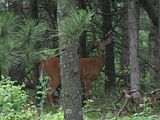

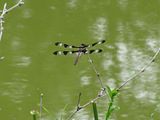



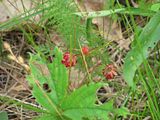









- Quads, hailing from Grand Marsh Observatory atop Elk Castle Hill
ISS Tomorrow Morning
24 Jun -1.6 03:29:49 S 39
- Quads, hailing from Grand Marsh Observatory atop Elk Castle Hill
- Quads, hailing from Grand Marsh Observatory atop Elk Castle Hill
From dark observing sites
From dark observing sites, the Milky Way arcs through the heavens from north to south. The Greeks and Romans thought this band of light looked like spilled milk. Today, we know that it is the combined glow of countless stars in the disk of our galaxy.
- Quads, hailing from Grand Marsh Observatory atop Elk Castle Hill
- Quads, hailing from Grand Marsh Observatory atop Elk Castle Hill
Monday, June 22, 2009
ISS Tomorrow Morning
23 Jun -2.2 04:37:55 WSW 70
- Quads, hailing from Grand Marsh Observatory atop Elk Castle Hill
- Quads, hailing from Grand Marsh Observatory atop Elk Castle Hill
Planet 'spotted' in Andromeda galaxy
Astronomers believe they may have discovered the first planet ever detected in another galaxy. The new world was apparently glimpsed in the closest giant spiral galaxy to the Milky Way, Messier 31 in the constellation of Andromeda. It lies an incredible 2.5 million light-years away - too far normally to be seen. But it revealed itself thanks to a phenomenon called microlensing where the gravitational field of an object closer to Earth acts like a magnifying glass.
It lies an incredible 2.5 million light-years away - too far normally to be seen.
But it revealed itself thanks to a phenomenon called microlensing where the gravitational field of an object closer to Earth acts like a magnifying glass.
Amazingly, it has taken the astronomers five years to realise that they probably netted an extra-galactic planet. They observed a peculiar microlensing event while studying the Andromeda galaxy - which can be seen as a dim blur with the unaided eye - in 2004.
The international team, using the UK's Isaac Newton Telescope on the Canary Island of La Palma, thought at the time that they had recorded a pair of stars orbiting each other.
But computer simulations and other calculations have persuaded them that they actually observed a star with a smaller, planet sized companion about six times bigger than Jupiter.
More than 300 so-called exoplanets have been found orbiting other stars in our own galaxy. And NASA has launched a $595 million spaceprobe called Kepler to watch 100,000 stars for signs of world like Earth.
source....
It lies an incredible 2.5 million light-years away - too far normally to be seen.
But it revealed itself thanks to a phenomenon called microlensing where the gravitational field of an object closer to Earth acts like a magnifying glass.
Amazingly, it has taken the astronomers five years to realise that they probably netted an extra-galactic planet. They observed a peculiar microlensing event while studying the Andromeda galaxy - which can be seen as a dim blur with the unaided eye - in 2004.
The international team, using the UK's Isaac Newton Telescope on the Canary Island of La Palma, thought at the time that they had recorded a pair of stars orbiting each other.
But computer simulations and other calculations have persuaded them that they actually observed a star with a smaller, planet sized companion about six times bigger than Jupiter.
More than 300 so-called exoplanets have been found orbiting other stars in our own galaxy. And NASA has launched a $595 million spaceprobe called Kepler to watch 100,000 stars for signs of world like Earth.
source....
Sunday, June 21, 2009
The Castle Rock Family ATV Club Scavenger Hunt - SUCCESS!
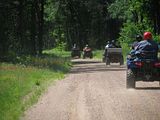

These pictures, and more, can be found on the picture page.
- Quads, hailing from Grand Marsh Observatory atop Elk Castle Hill
Fox steals more than 100 shoes
A fox has been unmasked as the mystery thief of more than 100 shoes in the small western German town of Foehren, authorities said Friday.
A forest worker stumbled upon shoes strewn near the fox's den and found a trove of footwear down the hole which had recently been stolen overnight from outside locals' front doors.
"There was everything from ladies' shoes to trainers," said a local police spokesman. "We've found between 110 and 120 so far. It seems a vixen stole them for her cubs to play with."
Although many were missing laces, the shoes were in good condition and their owners were delighted to reclaim them, he said, adding that no reprisals were planned against the culprit.
source....
A forest worker stumbled upon shoes strewn near the fox's den and found a trove of footwear down the hole which had recently been stolen overnight from outside locals' front doors.
"There was everything from ladies' shoes to trainers," said a local police spokesman. "We've found between 110 and 120 so far. It seems a vixen stole them for her cubs to play with."
Although many were missing laces, the shoes were in good condition and their owners were delighted to reclaim them, he said, adding that no reprisals were planned against the culprit.
source....
ISS Tomorrow Morning
22 Jun -1.4 04:13:46 SSW 37
- Quads, hailing from Grand Marsh Observatory atop Elk Castle Hill
- Quads, hailing from Grand Marsh Observatory atop Elk Castle Hill
Saturday, June 20, 2009
No Drought Yet This Year
Total rainfall yesterday: 3.60 inches
In the last three days: 5.55 inches
Two weeks: 8.50 inches
- Quads, hailing from Grand Marsh Observatory atop Elk Castle Hill
In the last three days: 5.55 inches
Two weeks: 8.50 inches
- Quads, hailing from Grand Marsh Observatory atop Elk Castle Hill
summer solstice
The summer solstice arrives at 12:46 a.m. CDT tomorrow, marking the start of summer in the northern hemisphere. The solstice occurs when the Sun stands farthest north in the sky for the year.
- Quads, hailing from Grand Marsh Observatory atop Elk Castle Hill
- Quads, hailing from Grand Marsh Observatory atop Elk Castle Hill
Boy Hit By Meteorite
Gerrit Blank was on his way to school when he saw a massive fireball heading straight towards him from the sky.
The white-hot meteorite bounced off the schoolboy's hand and hit the ground so hard it left a foot-long crater in the tarmac - as well as a three-inch scar on his hand.
Gerrit, 14, said: "At first I just saw a large ball of light and then I suddenly felt a pain in my hand.
"Then, a split second after that, there was an enormous bang like a crash of thunder."
"The noise that came after the flash of light was so loud that my ears were ringing for hours afterwards.
"When it hit me it knocked me flying and then was still going fast enough to bury itself in the road."
Scientists are now studying the pea-sized meteorite, which crashed to Earth in Essen in Germany.
Chemical tests on the rock have now proved it is from outer space.
Ansgar Korte, director of Germany's Walter Hohmann Observatory, said: "It's a real meteorite, therefore it is very valuable to collectors and scientists."
Chances of being struck by a meteorite are around one in 100 million.
Mr Korte said: "Most meteorites don't actually make it to ground level because they evaporate in the atmosphere.
"Of those that do get through, about six out of every seven of them land in water."
There is only one other known case of a human being surviving a direct hit from a meteor.
A grapefruit-sized meteor crashed through the roof of a house in Alabama, in the USA, in 1954.
After smashing through the top of the building, it bounced off furniture and then hit a woman who was asleep at the time.
source....
The white-hot meteorite bounced off the schoolboy's hand and hit the ground so hard it left a foot-long crater in the tarmac - as well as a three-inch scar on his hand.
Gerrit, 14, said: "At first I just saw a large ball of light and then I suddenly felt a pain in my hand.
"Then, a split second after that, there was an enormous bang like a crash of thunder."
"The noise that came after the flash of light was so loud that my ears were ringing for hours afterwards.
"When it hit me it knocked me flying and then was still going fast enough to bury itself in the road."
Scientists are now studying the pea-sized meteorite, which crashed to Earth in Essen in Germany.
Chemical tests on the rock have now proved it is from outer space.
Ansgar Korte, director of Germany's Walter Hohmann Observatory, said: "It's a real meteorite, therefore it is very valuable to collectors and scientists."
Chances of being struck by a meteorite are around one in 100 million.
Mr Korte said: "Most meteorites don't actually make it to ground level because they evaporate in the atmosphere.
"Of those that do get through, about six out of every seven of them land in water."
There is only one other known case of a human being surviving a direct hit from a meteor.
A grapefruit-sized meteor crashed through the roof of a house in Alabama, in the USA, in 1954.
After smashing through the top of the building, it bounced off furniture and then hit a woman who was asleep at the time.
source....
Friday, June 19, 2009
Heavy Rain
We got 3 1/4 inches of rain in one hour this afternoon, along with marble hail. Didn't seem to hurt the garden though. Funnel/wall cloud was spotted 2 miles south of our house.
- Quads, hailing from Grand Marsh Observatory atop Elk Castle Hill
- Quads, hailing from Grand Marsh Observatory atop Elk Castle Hill
Black River State Forest Conditions
Conditions as of Thursday, June 18, 2009:
All-terrain Vehicle (ATV) Trails
The Black River area received a considerable amount of rain this week. Trails are in fair condition with some wetter areas to be expected. Remember to stay on trails at all times. A section of trail from Campground Road to the Clay School Parking Lot is closed due to several areas with excessive water covering the trail and damage due to heavy ridership on Memorial Day Weekend. The extra rain this week has delayed the re opening of this section.
During this time of closure a temporary bypass route has been authorized with the Town of Komensky. Riders can travel north on Campground Road up to Clay School Road where they will turn west and meet up with the current ATV route. Please use the utmost respect while driving on this temporary route. Stay on the road at all times and be mindful of speed.
A 2.2-mile portion of the trail from Highway 54 to Bartos road is undergoing rehabilitation this spring. This section is open for weekend riding by 4 p.m. each Friday. While this section is closed we encourage people who want to ride up to Hatfield or to City Point to use our Clay School Road parking lot. Ride with caution on this stretch during the weekends as you may encounter rough areas due to the construction. We hope to have this section completed by the end of June next week and then to begin work on the stretch just south of Highway 54.
This project will protect the long term sustainability of the trail system and lessen the frequency of trail closings due to large rainfalls.
Memorial Day weekend there were eight ATV accidents in the Jackson and Clark County area including one fatal accident.
source....
All-terrain Vehicle (ATV) Trails
The Black River area received a considerable amount of rain this week. Trails are in fair condition with some wetter areas to be expected. Remember to stay on trails at all times. A section of trail from Campground Road to the Clay School Parking Lot is closed due to several areas with excessive water covering the trail and damage due to heavy ridership on Memorial Day Weekend. The extra rain this week has delayed the re opening of this section.
During this time of closure a temporary bypass route has been authorized with the Town of Komensky. Riders can travel north on Campground Road up to Clay School Road where they will turn west and meet up with the current ATV route. Please use the utmost respect while driving on this temporary route. Stay on the road at all times and be mindful of speed.
A 2.2-mile portion of the trail from Highway 54 to Bartos road is undergoing rehabilitation this spring. This section is open for weekend riding by 4 p.m. each Friday. While this section is closed we encourage people who want to ride up to Hatfield or to City Point to use our Clay School Road parking lot. Ride with caution on this stretch during the weekends as you may encounter rough areas due to the construction. We hope to have this section completed by the end of June next week and then to begin work on the stretch just south of Highway 54.
This project will protect the long term sustainability of the trail system and lessen the frequency of trail closings due to large rainfalls.
Memorial Day weekend there were eight ATV accidents in the Jackson and Clark County area including one fatal accident.
source....
THUNDERSTORMS ARE EXPECTED AGAIN TODAY INTO THIS EVENING.
WITH A
MOIST...UNSTABLE AIRMASS IN PLACE AND FAVORABLE WINDS ALOFT...A FEW
OF THESE COULD BECOME SEVERE. THE MAIN THREATS WOULD BE LARGE
HAIL...DAMAGING WINDS AND HEAVY RAINS. SHOULD MORE HEAVY RAINS
OCCUR...FLOODING WOULD BE A PROBLEM...ESPECIALLY OVER FAR NORTHEAST
IOWA AND FAR SOUTHWEST WISCONSIN WHERE HEAVY RAINS FELL THURSDAY
NIGHT.
- Quads, hailing from Grand Marsh Observatory atop Elk Castle Hill
MOIST...UNSTABLE AIRMASS IN PLACE AND FAVORABLE WINDS ALOFT...A FEW
OF THESE COULD BECOME SEVERE. THE MAIN THREATS WOULD BE LARGE
HAIL...DAMAGING WINDS AND HEAVY RAINS. SHOULD MORE HEAVY RAINS
OCCUR...FLOODING WOULD BE A PROBLEM...ESPECIALLY OVER FAR NORTHEAST
IOWA AND FAR SOUTHWEST WISCONSIN WHERE HEAVY RAINS FELL THURSDAY
NIGHT.
- Quads, hailing from Grand Marsh Observatory atop Elk Castle Hill
Swine Flu Pandemic DECLARED by World Health Organization Alert at Phase 6
On June 11, 2009, the World Health Organizatio (WHO) raised the worldwide pandemic alert level to Phase 6 in response to the ongoing global spread of the novel influenza A (H1N1) virus. A Phase 6 designation indicates that a global pandemic is underway.
More than 70 countries are now reporting cases of human infection with novel H1N1 flu. This number has been increasing over the past few weeks, but many of the cases reportedly had links to travel or were localized outbreaks without community spread. The WHO designation of a pandemic alert Phase 6 reflects the fact that there are now ongoing community level outbreaks in multiple parts of world.
WHO's decision to raise the pandemic alert level to Phase 6 is a reflection of the spread of the virus, not the severity of illness caused by the virus. It's uncertain at this time how serious or severe this novel H1N1 pandemic will be in terms of how many people infected will develop serious complications or die from novel H1N1 infection. Experience with this virus so far is limited and influenza is unpredictable. However, because novel H1N1 is a new virus, many people may have little or no immunity against it, and illness may be more severe and widespread as a result. In addition, currently there is no vaccine to protect against novel H1N1 virus.
In the United States, most people who have become ill with the newly declared pandemic virus have recovered without requiring medical treatment, however, CDC anticipates that there will be more cases, more hospitalizations and more deaths associated with this pandemic in the coming days and weeks. In addition, this virus could cause significant illness with associated hospitalizations and deaths in the fall and winter during the U.S. influenza season.
source....
More than 70 countries are now reporting cases of human infection with novel H1N1 flu. This number has been increasing over the past few weeks, but many of the cases reportedly had links to travel or were localized outbreaks without community spread. The WHO designation of a pandemic alert Phase 6 reflects the fact that there are now ongoing community level outbreaks in multiple parts of world.
WHO's decision to raise the pandemic alert level to Phase 6 is a reflection of the spread of the virus, not the severity of illness caused by the virus. It's uncertain at this time how serious or severe this novel H1N1 pandemic will be in terms of how many people infected will develop serious complications or die from novel H1N1 infection. Experience with this virus so far is limited and influenza is unpredictable. However, because novel H1N1 is a new virus, many people may have little or no immunity against it, and illness may be more severe and widespread as a result. In addition, currently there is no vaccine to protect against novel H1N1 virus.
In the United States, most people who have become ill with the newly declared pandemic virus have recovered without requiring medical treatment, however, CDC anticipates that there will be more cases, more hospitalizations and more deaths associated with this pandemic in the coming days and weeks. In addition, this virus could cause significant illness with associated hospitalizations and deaths in the fall and winter during the U.S. influenza season.
source....
Thursday, June 18, 2009
THERE WILL BE SOME TORNADOES ALONG AND SOUTH OF INTERSTATE 90
A WARM FRONT WILL MOVE NORTH ACROSS IOWA TODAY...AND SOUTHERN
MINNESOTA AND THE SOUTHERN HALF OF WISCONSIN TONIGHT. STRONG TO
SEVERE THUNDERSTORMS ARE EXPECTED TO DEVELOP ALONG AND NORTH OF
THIS FRONT. VERY HEAVY RAIN...LARGE HAIL...AND DAMAGING WINDS WILL
BE LIKELY ACROSS SOUTHEAST MINNESOTA...NORTHEAST IOWA...AND WEST
CENTRAL...CENTRAL...AND SOUTHWEST WISCONSIN FROM THIS AFTERNOON
THROUGH THIS EVENING. IN ADDITION...THERE WILL BE SOME TORNADOES
ALONG AND SOUTH OF INTERSTATE 90. AT THIS TIME...THE GREATEST
PROBABILITY OF SEVERE WEATHER LOOKS TO BE FROM 4 PM THROUGH
MIDNIGHT. IN ADDITION...ALL THE RAINFALL MAY RESULT IN LOCALIZED
FLOODING.
A LOW PRESSURE SYSTEM WILL PROVIDE ADDITIONAL CHANCES OF SEVERE
WEATHER ON FRIDAY. THE MAIN SEVERE WEATHER THREATS WILL BE LARGE
HAIL AND DAMAGING WINDS. IN ADDITION...A FEW TORNADOES WILL BE
POSSIBLE ACROSS NORTHEAST IOWA AND SOUTHWEST WISCONSIN.
- Quads, hailing from Grand Marsh Observatory atop Elk Castle Hill
MINNESOTA AND THE SOUTHERN HALF OF WISCONSIN TONIGHT. STRONG TO
SEVERE THUNDERSTORMS ARE EXPECTED TO DEVELOP ALONG AND NORTH OF
THIS FRONT. VERY HEAVY RAIN...LARGE HAIL...AND DAMAGING WINDS WILL
BE LIKELY ACROSS SOUTHEAST MINNESOTA...NORTHEAST IOWA...AND WEST
CENTRAL...CENTRAL...AND SOUTHWEST WISCONSIN FROM THIS AFTERNOON
THROUGH THIS EVENING. IN ADDITION...THERE WILL BE SOME TORNADOES
ALONG AND SOUTH OF INTERSTATE 90. AT THIS TIME...THE GREATEST
PROBABILITY OF SEVERE WEATHER LOOKS TO BE FROM 4 PM THROUGH
MIDNIGHT. IN ADDITION...ALL THE RAINFALL MAY RESULT IN LOCALIZED
FLOODING.
A LOW PRESSURE SYSTEM WILL PROVIDE ADDITIONAL CHANCES OF SEVERE
WEATHER ON FRIDAY. THE MAIN SEVERE WEATHER THREATS WILL BE LARGE
HAIL AND DAMAGING WINDS. IN ADDITION...A FEW TORNADOES WILL BE
POSSIBLE ACROSS NORTHEAST IOWA AND SOUTHWEST WISCONSIN.
- Quads, hailing from Grand Marsh Observatory atop Elk Castle Hill
beautiful solar-system lineup
A beautiful solar-system lineup will greet early risers tomorrow: the crescent Moon and the planets Venus and Mars. Venus is the "morning star" to the lower right of the Moon. Mars is roughly between them, a little closer to Venus.
- Quads, hailing from Grand Marsh Observatory atop Elk Castle Hill
- Quads, hailing from Grand Marsh Observatory atop Elk Castle Hill
It's raining tadpoles in Japan town, residents say
Meteorologists in Japan say the rainy season has just started in Tokyo, but residents in a small coastal town have reported a different phenomenon -- tadpoles dropping out of the sky.
An office clerk in Nanao said he first noticed the anomaly when he heard a dull thud in a parking lot last week, news reports said. Looking around, he saw about 100 dead amphibians splattered on car windshields and the ground.
More reports followed from bewildered residents in Nanao.
"People speculate that a waterspout picked them up and dropped them from the air," an official at a local weather observatory told AFP. "But from a meteorological point of view, I have to say it is most unlikely."
"We have checked the weather conditions of last week, thinking gusts of wind might have hit the area but confirmed no damage," he said. "To be honest, I don't think it was anything caused by a weather condition."
Similar events -- in what is sometimes called the "Fafrotskies" phenomenon, short for "fall from the sky" -- have been reported around the world, with whirlwinds passing over water bodies and picking up frogs, jellyfish or other unfortunate animals before dumping them back to earth.
source....
An office clerk in Nanao said he first noticed the anomaly when he heard a dull thud in a parking lot last week, news reports said. Looking around, he saw about 100 dead amphibians splattered on car windshields and the ground.
More reports followed from bewildered residents in Nanao.
"People speculate that a waterspout picked them up and dropped them from the air," an official at a local weather observatory told AFP. "But from a meteorological point of view, I have to say it is most unlikely."
"We have checked the weather conditions of last week, thinking gusts of wind might have hit the area but confirmed no damage," he said. "To be honest, I don't think it was anything caused by a weather condition."
Similar events -- in what is sometimes called the "Fafrotskies" phenomenon, short for "fall from the sky" -- have been reported around the world, with whirlwinds passing over water bodies and picking up frogs, jellyfish or other unfortunate animals before dumping them back to earth.
source....
Wednesday, June 17, 2009
POSSIBILITY OF A FEW TORNADOES
A LOW PRESSURE SYSTEM WILL MOVE SLOWLY EAST ACROSS THE REGION FROM
THURSDAY THROUGH FRIDAY NIGHT. AS THIS OCCURS...THERE WILL PERIODIC
THUNDERSTORMS. A FEW OF THESE THUNDERSTORMS MAY BECOME SEVERE FROM
THURSDAY THROUGH FRIDAY. THE MAIN SEVERE WEATHER THREATS WILL BE
LARGE HAIL AND DAMAGING WINDS ON THURSDAY AND THURSDAY NIGHT. ON
FRIDAY...THESE THREATS WILL CONTINUE ALONG WITH THE POSSIBILITY OF
A FEW TORNADOES.
- Quads, hailing from Grand Marsh Observatory atop Elk Castle Hill
THURSDAY THROUGH FRIDAY NIGHT. AS THIS OCCURS...THERE WILL PERIODIC
THUNDERSTORMS. A FEW OF THESE THUNDERSTORMS MAY BECOME SEVERE FROM
THURSDAY THROUGH FRIDAY. THE MAIN SEVERE WEATHER THREATS WILL BE
LARGE HAIL AND DAMAGING WINDS ON THURSDAY AND THURSDAY NIGHT. ON
FRIDAY...THESE THREATS WILL CONTINUE ALONG WITH THE POSSIBILITY OF
A FEW TORNADOES.
- Quads, hailing from Grand Marsh Observatory atop Elk Castle Hill
M13
Hercules isn't all that bright, but it contains one impressive object: the star cluster M13, which contains about 100,000 stars. To the unaided eye, it looks like a small, fuzzy patch of light. M13 is high in the east in late evening
- Quads, hailing from Grand Marsh Observatory atop Elk Castle Hill
- Quads, hailing from Grand Marsh Observatory atop Elk Castle Hill
Tuesday, June 16, 2009
RANGER RZR S takes first at WORCS and the Sportsman 850 XP takes Second at GNCC
The RANGER RZR S added another win to its impressive collection in WORCS, and the Sportsman 850 XP with power steering continues to show its brawn in the GNCC series.
Doug Eichner piloted his RANGER RZRS to a first-place finish at Riverdale Raceway, June 6-7, in Toutle, Washington.
Coming off Daryl Rath’s third place finish at GNCC’s “Mountain Ridge,” The Sportsman 850 XP EPS and Rath Racer Frank Batista took second in the “4x4 Open” class, at “The John Penton.” The win puts Batista in fifth place in the class rankings with teammate Daryl Rath sitting in second.
The next WORCS race is Aug. 14-16, in Olympia, Wash., and the next GNCC race is the MotorcycleUSA.com Snowshoe, June 27-28, in Snowshoe, West Virginia.
source....
Doug Eichner piloted his RANGER RZRS to a first-place finish at Riverdale Raceway, June 6-7, in Toutle, Washington.
Coming off Daryl Rath’s third place finish at GNCC’s “Mountain Ridge,” The Sportsman 850 XP EPS and Rath Racer Frank Batista took second in the “4x4 Open” class, at “The John Penton.” The win puts Batista in fifth place in the class rankings with teammate Daryl Rath sitting in second.
The next WORCS race is Aug. 14-16, in Olympia, Wash., and the next GNCC race is the MotorcycleUSA.com Snowshoe, June 27-28, in Snowshoe, West Virginia.
source....
Monday, June 15, 2009
News From The Observatory
A wonderful weekend! Family, friends, and fishing.
On Saturday we had a reunion of our family and friends here at the observatory. You could say it was a family reunion, because our friends are family to us! Everyone had a great time, and we all vowed to get together more often. Of course it doesn't always work out that way in our busy grownup lives, but even if we don't get together as often as we'd like, we still think of each other.
And then on Sunday we went fishing!
Peppermill Lake



Peppermill Lake

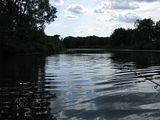
As we were getting ready to leave Peppermill Lake, we loaded the boat on the trailer and here was this snake at the landing. He was going way down to the bottom and chewing on a dead bullhead. He would spend a long time down there before he came up for air. Really neat to watch! He swam all around the boat, trailer, and us and didn't seem too scared. Only swimming away a little if we got real close.
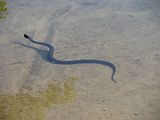
The poison ivy is blooming now. We'll have a bumper crop of poison ivy berries this Fall! The only nice thing about it is, the animals eat it and aren't allergic to it. Humans are the only things allergic to poison ivy. These pictures were taken in our backyard!
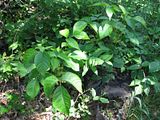

And, of course, the latest aircraft picture!

- Quads, hailing from Grand Marsh Observatory atop Elk Castle Hill
On Saturday we had a reunion of our family and friends here at the observatory. You could say it was a family reunion, because our friends are family to us! Everyone had a great time, and we all vowed to get together more often. Of course it doesn't always work out that way in our busy grownup lives, but even if we don't get together as often as we'd like, we still think of each other.
And then on Sunday we went fishing!









- Quads, hailing from Grand Marsh Observatory atop Elk Castle Hill
Castle Rock Family ATV Club Scavenger Hunt
Castle Rock Family ATV Club Scavenger Hunt will be held on June 20, 2009 at the Wilderness Bar & Grille (Sprague) at 10:00am. Daena M will again be master-minding the scavenger hunt and it will be a challenge. The day will start with a CRFAC Membership Meeting (a short one) and then proceed with the scavenger hunt. Participants will return to the Wilderness after completion of the hunt for snacks and awards. This is a rain or shine event. Hope to see you there!!!! http://www.crfatvc.com
- Quads, hailing from Grand Marsh Observatory atop Elk Castle Hill
- Quads, hailing from Grand Marsh Observatory atop Elk Castle Hill
KAGUYA (SELENE)
The Japan Aerospace Exploration Agency (JAXA) launched "KAGUYA (SELENE)" by the H-IIA Launch Vehicle at 10:31:01 a.m. on September 14, 2007 (JST) from Tanegashima Space Center (TNSC). The major objectives of the "KAGUYA" mission are to obtain scientific data of the lunar origin and evolution and to develop the technology for the future lunar exploration. "KAGUYA" consists of a main orbiting satellite at about 100km altitude and two small satellites (Relay Satellite and VRAD Satellite) in polar orbit. The orbiters will carry instruments for scientific investigation of the Moon, on the Moon, and from the Moon.
KAGUYA was descended to the 50km altitude from February 1, 2009 and then was descended again to 10-30km in Lower altitude (Perilune) from April 16, 2009. Finally, KAGUYA was impacted to the south-east of near side of the Moon on June 10, 2009 (GMT).
We are very appreciated for your support to KAGUYA mission.
source....
KAGUYA was descended to the 50km altitude from February 1, 2009 and then was descended again to 10-30km in Lower altitude (Perilune) from April 16, 2009. Finally, KAGUYA was impacted to the south-east of near side of the Moon on June 10, 2009 (GMT).
We are very appreciated for your support to KAGUYA mission.
source....
Saturday, June 13, 2009
ATV Olympics Event in Tigerton, WI
The "ATV Olympics" has something for everyone that enjoys all-terrain recreation. One thing you won't want to do is leave your ATV home: trail riding, challenge courses, wheelie contests, ATV Teeter Totter, treasure hunts, drag racing, spectator admission to the scheduled racing events and a poker run are all activities included at no extra charge with a paid weekend admission.
The event will take place at the Embarrass River ATV Park and the "Motozone" in Tigerton, WI, on July 18-19, 2009. The Embarrass River ATV Park is home to some of the most scenic trails in the state of Wisconsin. Well marked trails wind through 500 wooded acres and along the beautiful Embarrass River. Polaris, ITP, Parts Unlimited and other industry giants already utilize the location for magazine photo shoots thanks to the unbeatable scenery. The park is littered with riverside campsites and a full RV lot with electrical hook-ups.
Amenities include ATV washes, indoor restrooms and showers, laundry facilities, a volleyball court and horseshoe pits, both primitive and full hook-up campsites, an RV dump station and riverside camping.
The combination of the facility with the "ATV OLYMPICS" makes for a must attend event for any ATV enthusiast.
Motocross, TT and Cross Country events will satisfy the pallets of the hardcore racers as well as wet the pallets of the "curious, but not sure" group in attendance. Three new "utility" classes have been added to all disciplines to provide some hardcore racing without the pressure or fierce competition.
An ATV event just wouldn't fulfill its name if it didn't include a little mud bogging, and your sure to see plenty of that over the course of the weekend.
Mark your calendar for July 18-19, make your camping reservation and set your GPS for Tigerton, WI. Visit www.fantasymoto.com for complete weekend details.
source....
The event will take place at the Embarrass River ATV Park and the "Motozone" in Tigerton, WI, on July 18-19, 2009. The Embarrass River ATV Park is home to some of the most scenic trails in the state of Wisconsin. Well marked trails wind through 500 wooded acres and along the beautiful Embarrass River. Polaris, ITP, Parts Unlimited and other industry giants already utilize the location for magazine photo shoots thanks to the unbeatable scenery. The park is littered with riverside campsites and a full RV lot with electrical hook-ups.
Amenities include ATV washes, indoor restrooms and showers, laundry facilities, a volleyball court and horseshoe pits, both primitive and full hook-up campsites, an RV dump station and riverside camping.
The combination of the facility with the "ATV OLYMPICS" makes for a must attend event for any ATV enthusiast.
Motocross, TT and Cross Country events will satisfy the pallets of the hardcore racers as well as wet the pallets of the "curious, but not sure" group in attendance. Three new "utility" classes have been added to all disciplines to provide some hardcore racing without the pressure or fierce competition.
An ATV event just wouldn't fulfill its name if it didn't include a little mud bogging, and your sure to see plenty of that over the course of the weekend.
Mark your calendar for July 18-19, make your camping reservation and set your GPS for Tigerton, WI. Visit www.fantasymoto.com for complete weekend details.
source....
Friday, June 12, 2009
10th Anniversary Victory Vision Motorcycle Earns “Best of the Best” Industry Recognition
Victory Motorcycles 10th Anniversary Vision Tour bike has been recognized as the top touring motorcycle in the country by the Robb Report in its 21st annual “Best of the Best” issue.
“The 10th Anniversary Vision redefined the American motorcycle,” said Steve Menneto, general manager of Victory Motorcycles. “This bike pushes the boundaries of style, design and engineering as part of the most progressive line of American luxury-touring bikes on the road.”
Powered by Victory’s own 106-cubic-inch Freedom V-Twin engine with true 6-speed overdrive transmission, the luxury bike includes a GPS system, XM radio, a CB radio and intercom, beautifully blending top technology and power to create the new American motorcycle. Victory produced 100 of these limited-edition bikes and they sold out in seven minutes, making them coveted collectors’ items.
Victory Motorcycles has made its mark on the industry by creating a class-leading, full-line of premium cruiser and touring motorcycles based on creative styling and innovative engineering. With the introduction of award-winning motorcycles such as Vegas, Hammer, Kingpin and Vegas Jackpot, Victory Motorcycles has shown that an American company can design and build the most innovative bikes in the world.
source....
“The 10th Anniversary Vision redefined the American motorcycle,” said Steve Menneto, general manager of Victory Motorcycles. “This bike pushes the boundaries of style, design and engineering as part of the most progressive line of American luxury-touring bikes on the road.”
Powered by Victory’s own 106-cubic-inch Freedom V-Twin engine with true 6-speed overdrive transmission, the luxury bike includes a GPS system, XM radio, a CB radio and intercom, beautifully blending top technology and power to create the new American motorcycle. Victory produced 100 of these limited-edition bikes and they sold out in seven minutes, making them coveted collectors’ items.
Victory Motorcycles has made its mark on the industry by creating a class-leading, full-line of premium cruiser and touring motorcycles based on creative styling and innovative engineering. With the introduction of award-winning motorcycles such as Vegas, Hammer, Kingpin and Vegas Jackpot, Victory Motorcycles has shown that an American company can design and build the most innovative bikes in the world.
source....
Thursday, June 11, 2009
motorcycle going 147-miles per hour
Juneau County Deputy Leigh Neville-Neil said she initially clocked the motorcycle going 147-miles per hour traveling east on Highway 21 west of Necedah. The pursuit started at 7:10am Thursday morning. The motorcycle then turned south onto 7th Avenue and passed a school bus with its flashing red lights. The deputy said the operator slowed the crotch-rocket style cycle....but did not stop. Then he turned east onto 22nd Street West and then east onto Highway 21 again and headed towards the Village of Necedah. He turned south onto Oak Street near the fire station...went onto some grass....then back onto Highway 21 again going east.....then turned north onto Highway 80....still going about 100-mph in the Village of Necedah. Deputy Neville-Neil said she was going 132-mph and he was still able to out-distance her. Juneau County Sheriff Brent Oleson told her to back-off the pursuit at the wayside about 3-miles from the Wood County line. The chase ended at 7:30 Thursday morning with the suspect not being stopped. The deputy said the motorcycle was lime green and black in color and the male operator was wearing a full, black-colored helmet.
source....
source....
Wednesday, June 10, 2009
Izar
The binary star system known as Izar forms the second-brightest star of Boötes, the herdsman, which is high overhead at nightfall. Through a telescope, one of the stars looks orange while the other looks green.
- Quads, hailing from Grand Marsh Observatory atop Elk Castle Hill
- Quads, hailing from Grand Marsh Observatory atop Elk Castle Hill
Snow falls, in June
Bismarck, N.D. (AP) Snow has fallen in Dickinson in June, the first time in nearly 60 years the city has seen snow past May.
National Weather Service meteorologist Janine Vining in Bismarck says there were unofficial reports of a couple of inches of snow in Dickinson on Saturday.
Vining says snow in North Dakota in June is uncommon, though it's not unheard of. She says other parts of the state have seen June snow within the past 10 years.
Williston and Bismarck had received only rain as of mid-Saturday, but Vining said snow was possible in those cities later in the day.
source....
National Weather Service meteorologist Janine Vining in Bismarck says there were unofficial reports of a couple of inches of snow in Dickinson on Saturday.
Vining says snow in North Dakota in June is uncommon, though it's not unheard of. She says other parts of the state have seen June snow within the past 10 years.
Williston and Bismarck had received only rain as of mid-Saturday, but Vining said snow was possible in those cities later in the day.
source....
Tuesday, June 9, 2009
London's magical history uncorked from 'witch bottle'
A rare insight into the folk beliefs of 17th-century Britons has been gleaned from the analysis of a sealed "witch bottle" unearthed in Greenwich, London, in 2004.
Witch bottles were commonly buried to ward off spells during the late 16th and 17th centuries, but it is very rare to find one still sealed.
"So many have been dug up and their contents washed away down the sink," says Alan Massey, a retired chemist formerly at the University of Loughborough, UK, who has examined so-called "magical" artifacts and was asked to analyse the contents of the bottle. "This is the first one that has been opened scientifically."
During the 17th century, British people often blamed witches for any ill health or misfortune they suffered, says Massey. "The idea of the witch bottle was to throw the spell back on the witch," he says. "The urine and the bulb of the bottle represented the waterworks of the witch, and the theory was that the nails and the bent pins would aggravate the witch when she passed water and torment her so badly that she would take the spell back off you."
The salt-glazed jar was discovered 1.5 metres below ground by archaeologists from The Maritime Trust, a Greenwich-based charity that preserves historic sailing vessels. When it was shaken, the bottle splashed and rattled, and an X-ray showed pins and nails stuck in the neck, suggesting that it had been buried upside down.
Further computed tomography scans showed it to be half-filled with liquid, which later analysis showed to be human urine. The bottle also contained bent nails and pins, a nail-pierced leather "heart", fingernail clippings, navel fluff and hair. The presence of iron sulphide in the mixture also suggests that sulphur or brimstone had been added.
"Prior to this point, all we really knew about what was in witch bottles was what we read from documents from the 17th century," says Brian Hoggard, an independent expert on British witchcraft who helped analyse the bottle. These texts suggest "recipes" for filling a witch bottle, but don't tell us what actually went into them.
Sulphur is not mentioned in any recipe Massey has seen, although a previously discovered bottle seemed to contain the remains of some matches, he says. "If you think about where sulphur came from in those days, it spewed out of volcanic fumaroles from the underworld. It would have been the ideal thing to [kill] your witch, if you wished to."
Further analysis of the urine showed that it also contained cotinine, a metabolite of nicotine, suggesting that it came from a smoker, while the nail clippings appear quite manicured, suggesting that a person of some social standing created the bottle.
"It's confirming what 17th-century documents tell us about these bottles, how they were used and how you make them," says Owen Davies, a witchcraft expert at the University of Hertfordshire in Hatfield, UK. "The whole rationale for these bottles was sympathetic magic – so you put something intimate to the bewitched person in the bottle and then you put in bent pins and other unpleasant objects which are going to poison and cause great pain to the witch."
source....
Witch bottles were commonly buried to ward off spells during the late 16th and 17th centuries, but it is very rare to find one still sealed.
"So many have been dug up and their contents washed away down the sink," says Alan Massey, a retired chemist formerly at the University of Loughborough, UK, who has examined so-called "magical" artifacts and was asked to analyse the contents of the bottle. "This is the first one that has been opened scientifically."
During the 17th century, British people often blamed witches for any ill health or misfortune they suffered, says Massey. "The idea of the witch bottle was to throw the spell back on the witch," he says. "The urine and the bulb of the bottle represented the waterworks of the witch, and the theory was that the nails and the bent pins would aggravate the witch when she passed water and torment her so badly that she would take the spell back off you."
The salt-glazed jar was discovered 1.5 metres below ground by archaeologists from The Maritime Trust, a Greenwich-based charity that preserves historic sailing vessels. When it was shaken, the bottle splashed and rattled, and an X-ray showed pins and nails stuck in the neck, suggesting that it had been buried upside down.
Further computed tomography scans showed it to be half-filled with liquid, which later analysis showed to be human urine. The bottle also contained bent nails and pins, a nail-pierced leather "heart", fingernail clippings, navel fluff and hair. The presence of iron sulphide in the mixture also suggests that sulphur or brimstone had been added.
"Prior to this point, all we really knew about what was in witch bottles was what we read from documents from the 17th century," says Brian Hoggard, an independent expert on British witchcraft who helped analyse the bottle. These texts suggest "recipes" for filling a witch bottle, but don't tell us what actually went into them.
Sulphur is not mentioned in any recipe Massey has seen, although a previously discovered bottle seemed to contain the remains of some matches, he says. "If you think about where sulphur came from in those days, it spewed out of volcanic fumaroles from the underworld. It would have been the ideal thing to [kill] your witch, if you wished to."
Further analysis of the urine showed that it also contained cotinine, a metabolite of nicotine, suggesting that it came from a smoker, while the nail clippings appear quite manicured, suggesting that a person of some social standing created the bottle.
"It's confirming what 17th-century documents tell us about these bottles, how they were used and how you make them," says Owen Davies, a witchcraft expert at the University of Hertfordshire in Hatfield, UK. "The whole rationale for these bottles was sympathetic magic – so you put something intimate to the bewitched person in the bottle and then you put in bent pins and other unpleasant objects which are going to poison and cause great pain to the witch."
source....
Vega
Vega, the brightest star in the summer sky, is climbing to prominence this week. It is well up in the northeast as darkness falls, and stands directly overhead around 2 or 3 a.m.
- Quads, hailing from Grand Marsh Observatory atop Elk Castle Hill
- Quads, hailing from Grand Marsh Observatory atop Elk Castle Hill
Monday, June 8, 2009
the Summer Triangle
The bright stars that mark the Summer Triangle are moving into the evening sky. The stars are Vega, in the constellation Lyra; Deneb, the "tail" of Cygnus, the swan; and Altair, in Aquila, the eagle. They are in the east at nightfall.
- Quads, hailing from Grand Marsh Observatory atop Elk Castle Hill
- Quads, hailing from Grand Marsh Observatory atop Elk Castle Hill
National Get Outdoors Day June 13
‘Get Outdoors! Wisconsin’ has events planned all summer long
As a consortium of federal agencies, nonprofit organizations and the recreation industry gear up for National Get Outdoors Day 2009 on June 13, visitors to Wisconsin State Parks, Forests and Trails can look forward to a full summer of “Get Outdoors! Wisconsin” events being held around the state.
The Wisconsin State Park System has launched a “Get Outdoors! Wisconsin” initiative with events scheduled throughout the summer at state parks, forests, trails and recreation areas. The events are indicated by a “Get Outdoors! Wisconsin” insignia on the Upcoming Events at Wisconsin State Parks, Forests and Trails Web page of the DNR Web site.
“Both National Get Outdoors Day and Get Outdoors! Wisconsin are aimed at getting children and families to spend more time outdoors with nature,” says Dan Schuller, director of the Wisconsin State Parks program.
Schuller says "Get Outdoors! Wisconsin" addresses a growing problem that author Richard Louv has termed “nature deficit disorder,” which has come about as children spend more time watching television and playing computer and video games. Many health professionals believe this has contributed to an increase in childhood obesity rates, which have risen four-fold for children ages 6 through 11 since 1971.
“Nature is good for kids. Research has shown that children who interact regularly with nature have better cognitive and creative skills and a better ability to deal with stress,” Schuller says.
Schuller notes that a “Top 10” list of reasons for a National Get Outdoors Day identifies many of the same reasons the State Parks program started its Get Outdoors! Wisconsin initiative.
More than a dozen “Get Outdoors! Wisconsin” events were scheduled this past weekend as part of National Trails Day on Saturday, June 6 and State Parks Open House Day yesterday, June 7.
More information on the national effort and specific events can be found at [www.nationalgetoutdoorsday.org] and Get Outdoors! Wisconsin.
Top 10 Reasons for National Get Outdoors Day
10) A smaller and smaller portion of the nation is deriving physical, mental and spiritual benefits from time on their lands, and use is especially low for America’s poor, our urban dwellers, and minority Americans.
9) Today’s American kids are less connected to the outdoors than any previous generation. 6.5 hours a day spent watching screens. Six times more likely to play a computer game than ride a bike. Four times more likely to be obese than previous generation. And now facing shorter lives – a decline of 2-5 years in average length of life from parents’ life expectation.
8) America’s youth tell us that we are not reaching them with invitations to be active outdoors because we are not using the communications channels they utilize most: social networking sites including YouTube and MySpace and text messaging and photo-sharing from phone to phone. They tell us they are interested in the outdoors but need "triggers," and National Get Outdoors Day intends to be a trigger.
7) Americans are overwhelmed with information over the Internet. Information on what to do and where to do it is available – but we need to help Americans find it!
6) Americans who volunteer are also likely to be healthier. There are abundant opportunities to get healthy by volunteering on public lands.
5) America’s public lands and water agencies and the recreation community need to work as a team to compete for the hearts and minds of 21st Century Americans. We aren’t talking about choices between biking and fishing for most Americans, but between malls and home-based technologies and the outdoors.
4) The future of America's public lands will be determined by the extent to which Americans care about the Great Outdoors -- and if fewer people directly benefit from time outdoors, the prognosis is not good.
3) Americans have a growing problem that can be addressed with more physical activity – an increase in the percentage of Americans who are overweight and obese. This trend carries with it big costs – in dollars and quality of life. Some $160 billion in direct public spending. 7 in 10 deaths now attributable to largely preventable chronic illnesses – and 3 out of every 4 dollars in our healthcare spending is similarly directed at largely preventable chronic illnesses.
2) Combating stress: About to Burst: Handling Stress and Ending Violence by Rebecca Radcliffe. Teenagers live in a world that is more stressed than ever before. They get overloaded with pressure at school, conflicts at home, relationship problems, and career choices. Many have to deal with divorce, moves, financial struggles, jobs, and blended families. When stress builds up, teens cope however they can. They may drink, drive aggressively, get high, overeat, go shopping, spend hours on the computer or playing video games, or take out their frustration on others. This is why we see increased bullying, isolation, depression, obesity, eating disorders, inappropriate sexual activity, violent outbursts, cutting, intolerance and hate crimes, suicide, and many other destructive choices. Kids need new and better choices. They need help unwinding and handling pressure in positive ways. Recreation is a powerful antidote to stress.
1) American families, American communities and the nation need the connectivity and unity that results from family and friends enjoying time in the outdoors.
source....
As a consortium of federal agencies, nonprofit organizations and the recreation industry gear up for National Get Outdoors Day 2009 on June 13, visitors to Wisconsin State Parks, Forests and Trails can look forward to a full summer of “Get Outdoors! Wisconsin” events being held around the state.
The Wisconsin State Park System has launched a “Get Outdoors! Wisconsin” initiative with events scheduled throughout the summer at state parks, forests, trails and recreation areas. The events are indicated by a “Get Outdoors! Wisconsin” insignia on the Upcoming Events at Wisconsin State Parks, Forests and Trails Web page of the DNR Web site.
“Both National Get Outdoors Day and Get Outdoors! Wisconsin are aimed at getting children and families to spend more time outdoors with nature,” says Dan Schuller, director of the Wisconsin State Parks program.
Schuller says "Get Outdoors! Wisconsin" addresses a growing problem that author Richard Louv has termed “nature deficit disorder,” which has come about as children spend more time watching television and playing computer and video games. Many health professionals believe this has contributed to an increase in childhood obesity rates, which have risen four-fold for children ages 6 through 11 since 1971.
“Nature is good for kids. Research has shown that children who interact regularly with nature have better cognitive and creative skills and a better ability to deal with stress,” Schuller says.
Schuller notes that a “Top 10” list of reasons for a National Get Outdoors Day identifies many of the same reasons the State Parks program started its Get Outdoors! Wisconsin initiative.
More than a dozen “Get Outdoors! Wisconsin” events were scheduled this past weekend as part of National Trails Day on Saturday, June 6 and State Parks Open House Day yesterday, June 7.
More information on the national effort and specific events can be found at [www.nationalgetoutdoorsday.org] and Get Outdoors! Wisconsin.
Top 10 Reasons for National Get Outdoors Day
10) A smaller and smaller portion of the nation is deriving physical, mental and spiritual benefits from time on their lands, and use is especially low for America’s poor, our urban dwellers, and minority Americans.
9) Today’s American kids are less connected to the outdoors than any previous generation. 6.5 hours a day spent watching screens. Six times more likely to play a computer game than ride a bike. Four times more likely to be obese than previous generation. And now facing shorter lives – a decline of 2-5 years in average length of life from parents’ life expectation.
8) America’s youth tell us that we are not reaching them with invitations to be active outdoors because we are not using the communications channels they utilize most: social networking sites including YouTube and MySpace and text messaging and photo-sharing from phone to phone. They tell us they are interested in the outdoors but need "triggers," and National Get Outdoors Day intends to be a trigger.
7) Americans are overwhelmed with information over the Internet. Information on what to do and where to do it is available – but we need to help Americans find it!
6) Americans who volunteer are also likely to be healthier. There are abundant opportunities to get healthy by volunteering on public lands.
5) America’s public lands and water agencies and the recreation community need to work as a team to compete for the hearts and minds of 21st Century Americans. We aren’t talking about choices between biking and fishing for most Americans, but between malls and home-based technologies and the outdoors.
4) The future of America's public lands will be determined by the extent to which Americans care about the Great Outdoors -- and if fewer people directly benefit from time outdoors, the prognosis is not good.
3) Americans have a growing problem that can be addressed with more physical activity – an increase in the percentage of Americans who are overweight and obese. This trend carries with it big costs – in dollars and quality of life. Some $160 billion in direct public spending. 7 in 10 deaths now attributable to largely preventable chronic illnesses – and 3 out of every 4 dollars in our healthcare spending is similarly directed at largely preventable chronic illnesses.
2) Combating stress: About to Burst: Handling Stress and Ending Violence by Rebecca Radcliffe. Teenagers live in a world that is more stressed than ever before. They get overloaded with pressure at school, conflicts at home, relationship problems, and career choices. Many have to deal with divorce, moves, financial struggles, jobs, and blended families. When stress builds up, teens cope however they can. They may drink, drive aggressively, get high, overeat, go shopping, spend hours on the computer or playing video games, or take out their frustration on others. This is why we see increased bullying, isolation, depression, obesity, eating disorders, inappropriate sexual activity, violent outbursts, cutting, intolerance and hate crimes, suicide, and many other destructive choices. Kids need new and better choices. They need help unwinding and handling pressure in positive ways. Recreation is a powerful antidote to stress.
1) American families, American communities and the nation need the connectivity and unity that results from family and friends enjoying time in the outdoors.
source....
Sunday, June 7, 2009
Polaris and Local Dealers Provide RANGERs
Polaris Industries announced the company is working with West Virginia Dealers, Keefer’s and Route 119 Powersports, to provide two RANGER Side-by-Side vehicles to EMS and other rescue services so they can carry water and help families affected by the flooding. Pennsylvania dealership, Hernley’s, also has joined the cause and sent a group of people with relief packages to help with the clean up.
“What has happened in southern West Virginia is a great tragedy,” said Daniel Storm, district sales manager for Polaris. “The dealerships are happy to help support an area who has been highly supportive of the sport of ATV riding. We hope the efforts can help this community get back on their feet quicker.”
One of the hardest areas hit was Gilbert, WV, home of the Hatfield McCoy National Trailfest. The flood was the largest natural disaster in the history of the town with approximately 4000 homes sustaining significant damage or completely destroyed in the county. Four other counties in both West Virginia and Eastern Kentucky also sustained significant dwelling & business losses.
source....
“What has happened in southern West Virginia is a great tragedy,” said Daniel Storm, district sales manager for Polaris. “The dealerships are happy to help support an area who has been highly supportive of the sport of ATV riding. We hope the efforts can help this community get back on their feet quicker.”
One of the hardest areas hit was Gilbert, WV, home of the Hatfield McCoy National Trailfest. The flood was the largest natural disaster in the history of the town with approximately 4000 homes sustaining significant damage or completely destroyed in the county. Four other counties in both West Virginia and Eastern Kentucky also sustained significant dwelling & business losses.
source....
Short Moon
The full Moon scoots across the sky tonight. It is known as the Flower Moon, Rose Moon, or Strawberry Moon. But another good name might be the Short Moon, because it's in the sky for less time than any other full Moon of the year -- only about eight or nine hours from most of the Lower 48 states.
- Quads, hailing from Grand Marsh Observatory atop Elk Castle Hill
- Quads, hailing from Grand Marsh Observatory atop Elk Castle Hill
Saturday, June 6, 2009
Wood stoves reduce heating bill
Forest fires have burned naturally in this area for millions of years, long before humans ever lived in the area.
When I burn wood in my stove it means that my family is warm and safe no matter what happens. I am not directly dependent on the power grid, natural gas or oil to survive the cold weather. The next time you want to put in a complaint about wood stoves, think about where you would go in the middle of the winter if the power went out for a long period of time. My guess is that you would eventually be huddled up next to a fire somewhere.
The alternative heat sources Canadians have at this point do much more damage to our environment. If someone was to knock on my door and ask me to put out my wood stove, my response would be this: "Are you going to pay my heating bills?"
Jeramie Geensen
Prince George
source....
When I burn wood in my stove it means that my family is warm and safe no matter what happens. I am not directly dependent on the power grid, natural gas or oil to survive the cold weather. The next time you want to put in a complaint about wood stoves, think about where you would go in the middle of the winter if the power went out for a long period of time. My guess is that you would eventually be huddled up next to a fire somewhere.
The alternative heat sources Canadians have at this point do much more damage to our environment. If someone was to knock on my door and ask me to put out my wood stove, my response would be this: "Are you going to pay my heating bills?"
Jeramie Geensen
Prince George
source....
Friday, June 5, 2009
News From The Observatory
I haven't done much night sky observing or astrophotography lately. It gets dark too late now. Soon the days will be getting shorter again and by then the Summer Milky Way will be up in a good spot too. While I was letting the dogs out last night around midnight, a really bright meteor happened to go overhead. It was one of those that goes clear across the sky and almost to the horizon on the other side. It was throwing sparks and slowly broke up into a beautiful shower before fading away.
Normally the last day for the woodstove fire is on Memorial Day Weekend. Not this year though. I've still had a fire in it almost every night. By the sound of the forecast I might have a fire during the day this weekend too! I've been cutting a little wood, and keeping up with firewood customers. Seems like every time I go somewhere, I come home and have to haul more firewood in the dark to replenish my "for sale firewood". Karen sells all that I have for sale when I'm gone! Excellent.
Despite the unusually cool weather, my garden is doing well. We've been eating winter onions and the radishes are about ready to start harvesting. I gave everything a shot of fertilizer the other day and weeded it completely. Looking good, barring any acts of "god".
The other morning when I was milking the cows my back started hurting (also nothing unusual for me, that and headaches). No big deal, I just have to keep moving and working. If I set around it hurts more! I decided to complete a project to keep my mind off of it. Awhile ago we bought a rotator for our TV antenna. We've never had one. I thought it might be nice to see what stations we can get from more directions than one now that they have all those new digital channels. I set out to do that yesterday. My plan was to use all the existing equipment, antenna etc., and just put up the rotator.
I took it down and got it all set up just like I wanted it. I cleaned all the old connections on the antennas (I had two, one for UHF and one for VFH) and was all ready to put it back up. The antennas were mounted on a couple old pieces of water pipe, with a pipe coupler in the middle instead of regular antenna mast. Normally if Karen had been home I would have had her stand on the ground and steady the mast while I was on the roof and walked it up into position.
Well, I don't have many helpers and I am so used to doing things myself that sometimes shit happens. Karen was at work, but the pipe/antenna/rotator assembly didn't seem too heavy. I stood on the ground and started walking the antenna up, with the pipe sliding on the drip edge of the roof as I went along. The pipe coupling got to the edge of the roof and .............. IT SNAPPED! The coupling was rusted and thin and it snapped clean! The antennas, rotator, the whole works came crashing down on the rooftop and hung over the house on the other side. Smashed everything all to hell! Both antennas were totally destroyed, the preamplifier was mangled, even broke the top off the new fresh out of the box $100 rotator! I guess I should have left well enough alone.
Anyway, I made a mad dash to the Lake Delton Radio Shack in my old jalopy of a truck and had to buy new everything. In the process of looking at new antenna mast, I hooked my finger on a sharp edge and bled all over their store. Fortunately I had a handkerchief in my pocket, but I didn't even know I had cut my finger until I noticed the salesman wiping blood off of things! Oops, sorry.
Anyway, to make an already long story longer, when I got home from Radio Shack it was time to milk FB's cows. After that, I finished putting up my $448 worth of new antenna stuff just past midnight last night. Now since I can rotate the antenna I get channels that I had never even heard of! I guess it was well worth the investment, even if it didn't turn out the way I had originally planned it (certainly way more expensive than the original plan). It's still cheaper in the long run.
Now, there is a couple trees branches that are a little too close for comfort to the antenna. I'm going out to take care of those right now, or attempt to. Money and help are so hard for me to come by that I don't want to take any chances of the wind whipping those branches into my new antenna and damaging it. Unfortunately I can't reach them with my pole saw, even when standing on my ladder. I will either shoot them off with my shotgun (yep, real redneck here), throw a rope over them and rip them down with my Polaris Hawkeye ATV (more redneck), or maybe I can at least pull them down far enough to reach with the pole saw.
Wish me luck!
- Quads, hailing from Grand Marsh Observatory atop Elk Castle Hill
Normally the last day for the woodstove fire is on Memorial Day Weekend. Not this year though. I've still had a fire in it almost every night. By the sound of the forecast I might have a fire during the day this weekend too! I've been cutting a little wood, and keeping up with firewood customers. Seems like every time I go somewhere, I come home and have to haul more firewood in the dark to replenish my "for sale firewood". Karen sells all that I have for sale when I'm gone! Excellent.
Despite the unusually cool weather, my garden is doing well. We've been eating winter onions and the radishes are about ready to start harvesting. I gave everything a shot of fertilizer the other day and weeded it completely. Looking good, barring any acts of "god".
The other morning when I was milking the cows my back started hurting (also nothing unusual for me, that and headaches). No big deal, I just have to keep moving and working. If I set around it hurts more! I decided to complete a project to keep my mind off of it. Awhile ago we bought a rotator for our TV antenna. We've never had one. I thought it might be nice to see what stations we can get from more directions than one now that they have all those new digital channels. I set out to do that yesterday. My plan was to use all the existing equipment, antenna etc., and just put up the rotator.
I took it down and got it all set up just like I wanted it. I cleaned all the old connections on the antennas (I had two, one for UHF and one for VFH) and was all ready to put it back up. The antennas were mounted on a couple old pieces of water pipe, with a pipe coupler in the middle instead of regular antenna mast. Normally if Karen had been home I would have had her stand on the ground and steady the mast while I was on the roof and walked it up into position.
Well, I don't have many helpers and I am so used to doing things myself that sometimes shit happens. Karen was at work, but the pipe/antenna/rotator assembly didn't seem too heavy. I stood on the ground and started walking the antenna up, with the pipe sliding on the drip edge of the roof as I went along. The pipe coupling got to the edge of the roof and .............. IT SNAPPED! The coupling was rusted and thin and it snapped clean! The antennas, rotator, the whole works came crashing down on the rooftop and hung over the house on the other side. Smashed everything all to hell! Both antennas were totally destroyed, the preamplifier was mangled, even broke the top off the new fresh out of the box $100 rotator! I guess I should have left well enough alone.
Anyway, I made a mad dash to the Lake Delton Radio Shack in my old jalopy of a truck and had to buy new everything. In the process of looking at new antenna mast, I hooked my finger on a sharp edge and bled all over their store. Fortunately I had a handkerchief in my pocket, but I didn't even know I had cut my finger until I noticed the salesman wiping blood off of things! Oops, sorry.
Anyway, to make an already long story longer, when I got home from Radio Shack it was time to milk FB's cows. After that, I finished putting up my $448 worth of new antenna stuff just past midnight last night. Now since I can rotate the antenna I get channels that I had never even heard of! I guess it was well worth the investment, even if it didn't turn out the way I had originally planned it (certainly way more expensive than the original plan). It's still cheaper in the long run.
Now, there is a couple trees branches that are a little too close for comfort to the antenna. I'm going out to take care of those right now, or attempt to. Money and help are so hard for me to come by that I don't want to take any chances of the wind whipping those branches into my new antenna and damaging it. Unfortunately I can't reach them with my pole saw, even when standing on my ladder. I will either shoot them off with my shotgun (yep, real redneck here), throw a rope over them and rip them down with my Polaris Hawkeye ATV (more redneck), or maybe I can at least pull them down far enough to reach with the pole saw.
Wish me luck!
- Quads, hailing from Grand Marsh Observatory atop Elk Castle Hill
New Memory Material May Hold Data For One Billion Years
Packing more digital images, music, and other data onto silicon chips in USB drives and smart phones is like squeezing more strawberries into the same size supermarket carton. The denser you pack, the quicker it spoils. The 10 to 100 gigabits of data per square inch on today's memory cards has an estimated life expectancy of only 10 to 30 years. And the electronics industry needs much greater data densities for tomorrow's iPods, smart phones, and other devices.
Scientists are reporting an advance toward remedying this situation with a new computer memory device that can store thousands of times more data than conventional silicon chips with an estimated lifetime of more than one billion years. Their discovery is scheduled for publication in the June 10 issue of the American Chemical Society's Nano Letters, a monthly journal.
Alex Zettl and colleagues note in the new study that some of today's highest-density experimental storage media can retain ultra-dense data for only a fraction of a second. They note that William the Conqueror's Doomsday Book, written on vellum in 1086 AD, has survived 900 years. However, the medium used for a digital version of the book, encoded in 1986, failed within 20 years.
The researchers describe development of an experimental memory device consisting of an iron nanoparticle (1/50,000 the width of a human hair) enclosed in a hollow carbon nanotube. In the presence of electricity, the nanoparticle can be shuttled back and forth with great precision. This creates a programmable memory system that, like a silicon chip, can record digital information and play it back using conventional computer hardware. In lab and theoretical studies, the researchers showed that the device had a storage capacity as high as 1 terabyte per square inch (a trillion bits of information) and temperature-stability in excess of one billion years.
source....
Scientists are reporting an advance toward remedying this situation with a new computer memory device that can store thousands of times more data than conventional silicon chips with an estimated lifetime of more than one billion years. Their discovery is scheduled for publication in the June 10 issue of the American Chemical Society's Nano Letters, a monthly journal.
Alex Zettl and colleagues note in the new study that some of today's highest-density experimental storage media can retain ultra-dense data for only a fraction of a second. They note that William the Conqueror's Doomsday Book, written on vellum in 1086 AD, has survived 900 years. However, the medium used for a digital version of the book, encoded in 1986, failed within 20 years.
The researchers describe development of an experimental memory device consisting of an iron nanoparticle (1/50,000 the width of a human hair) enclosed in a hollow carbon nanotube. In the presence of electricity, the nanoparticle can be shuttled back and forth with great precision. This creates a programmable memory system that, like a silicon chip, can record digital information and play it back using conventional computer hardware. In lab and theoretical studies, the researchers showed that the device had a storage capacity as high as 1 terabyte per square inch (a trillion bits of information) and temperature-stability in excess of one billion years.
source....
Thursday, June 4, 2009
ROSWELL DEBRIS CONFIRMED AS EXTRATERRESTRIAL: Lab Located, Scientists Named
Newly discovered documents reveal that in the months immediately following the purported 1947 UFO crash at Roswell, secret government studies began on a material that was previously unknown to science. The "memory metal" that was studied precisely matches some of the debris material reported by several witnesses to the crash. Evidence shows that -under military direction- these unique metal studies were undertaken by a contracted laboratory that possessed advanced technical capabilities that the U.S. government itself did not have at the time. A former high-level scientist employed by the involved laboratory has offered a confession that he was tasked to study the crashed UFO material. Information provided by two U.S. Air Force Generals also offers direct support for this discovery.
The documents suggest that after the crash, the US government attempted to develop a unique material that is today referred to as memory metal. This shape-recovery alloy was reported by several witnesses to the Roswell crash in the summer of 1947. The lightweight "morphing" material was able to be crumpled or deformed and then return itself instantly and seamlessly to its original state. The metallurgical discoveries that resulted from these studies were then "seeded" for further technology development to other government agencies (including NASA) and through a series of military contracts to universities and industry.
The laboratory contracted by Wright Patterson Air Force Base to perform these studies was Battelle Memorial Institute in Columbus, OH. It has been credibly reported that Wright Patterson Air Force Base was the very base where the Roswell UFO debris was flown after the crash.
source....
The documents suggest that after the crash, the US government attempted to develop a unique material that is today referred to as memory metal. This shape-recovery alloy was reported by several witnesses to the Roswell crash in the summer of 1947. The lightweight "morphing" material was able to be crumpled or deformed and then return itself instantly and seamlessly to its original state. The metallurgical discoveries that resulted from these studies were then "seeded" for further technology development to other government agencies (including NASA) and through a series of military contracts to universities and industry.
The laboratory contracted by Wright Patterson Air Force Base to perform these studies was Battelle Memorial Institute in Columbus, OH. It has been credibly reported that Wright Patterson Air Force Base was the very base where the Roswell UFO debris was flown after the crash.
source....
Wednesday, June 3, 2009
Scientists Call Hubble a 'Whole New Telescope' After Repairs
The Hubble Space Telescope appears better than new as NASA puts the 19-year-old observatory through a battery of tests after its final facelift by an astronaut repair crew.
Ed Weiler, NASA's science missions chief, said Hubble is in the midst of meticulous systems and calibration checks following the successful upgrades and repairs by Atlantis shuttle astronauts.
The calibrations and electronics tests should run their course by the end of summer, with a new and improved Hubble once more ready for science observations in late August, Weiler said.
Commanded by veteran spaceflyer Scott Altman, the Atlantis astronauts launched toward Hubble on May 11 and performed a five-spacewalk marathon that left the iconic space observatory more powerful than ever before.
source....
Ed Weiler, NASA's science missions chief, said Hubble is in the midst of meticulous systems and calibration checks following the successful upgrades and repairs by Atlantis shuttle astronauts.
The calibrations and electronics tests should run their course by the end of summer, with a new and improved Hubble once more ready for science observations in late August, Weiler said.
Commanded by veteran spaceflyer Scott Altman, the Atlantis astronauts launched toward Hubble on May 11 and performed a five-spacewalk marathon that left the iconic space observatory more powerful than ever before.
source....
Tuesday, June 2, 2009
The Sun’s Demise
After forming out of a cloud of gas and dust, a mid-sized star like our Sun sits nicely on the main sequence and burns hydrogen in its core for some 5 billion years. Then, the end begins.
* Stars on the main sequence fuse hydrogen into helium in their cores, releasing heat and light for tens of millions to billions of years. Massive stars burn fast, hot, and blue; less massive stars burn slow, cool, and white or yellow or red. Eventually, all but the smallest stars run out of hydrogen, and that’s when they start burning heavier elements in the core and quickly evolve off the main sequence.
* After 5-10 billion years, when a mid-sized star like our Sun runs low on hydrogen, nuclear fusion in the core slows. With less light to push back against gravity, the star contracts and heats the helium-rich core, re-igniting a thin shell of hydrogen, which pushes out the star’s atmosphere.
* The star cools and swells by 50-100 times, becoming a red giant. Planets closest to the star may get swallowed up. This fate awaits Mercury and Venus. Earth may be spared, but the Sun will expand to fill much of our sky.
* In some cases, depending on the star’s mass, the helium core will be squeezed enough to suddenly ignite in what’s called the “helium flash“. This expels as much energy as 100,000,000 Suns. But the flash is brief, and the released energy does not disturb the outer layers of the star.
* After helium starts burning, the hydrogen shell around the core expands and cools, which means the outer layers of the star contract again. The star shrinks, but does not return to the main sequence.
* Helium burning is notoriously unstable, so the star begins to pulsate irregularly. Mira is an example of a star in this late phase of life. The outer layers are expelled as a planetary nebula. Once the helium is finished burning, the core becomes rich in carbon and oxygen. The core collapses again, but this time it doesn’t get hot enough to continue burning. What’s left of the core becomes a white dwarf.
* The sun has enough hydrogen fuel to burn for 5 billion more years before it enters the red giant stage. But here’s the kicker… as the hydrogen burns, the Sun slowly contracts and becomes too hot to comfortably sustain life on Earth. This will happen not in 5 billion years, but just 500 million years. So plan accordingly.
A little knowledge of star types will help you better understand what you see in the sky. For example, go out on a fine spring night and find Arcturus in the constellation Bootes. It’s a red giant star and it’s at this very moment burning a shell of hydrogen near its core; our Sun will look very much like this in some 6 -7 billion years. Now you know why.
source....
* Stars on the main sequence fuse hydrogen into helium in their cores, releasing heat and light for tens of millions to billions of years. Massive stars burn fast, hot, and blue; less massive stars burn slow, cool, and white or yellow or red. Eventually, all but the smallest stars run out of hydrogen, and that’s when they start burning heavier elements in the core and quickly evolve off the main sequence.
* After 5-10 billion years, when a mid-sized star like our Sun runs low on hydrogen, nuclear fusion in the core slows. With less light to push back against gravity, the star contracts and heats the helium-rich core, re-igniting a thin shell of hydrogen, which pushes out the star’s atmosphere.
* The star cools and swells by 50-100 times, becoming a red giant. Planets closest to the star may get swallowed up. This fate awaits Mercury and Venus. Earth may be spared, but the Sun will expand to fill much of our sky.
* In some cases, depending on the star’s mass, the helium core will be squeezed enough to suddenly ignite in what’s called the “helium flash“. This expels as much energy as 100,000,000 Suns. But the flash is brief, and the released energy does not disturb the outer layers of the star.
* After helium starts burning, the hydrogen shell around the core expands and cools, which means the outer layers of the star contract again. The star shrinks, but does not return to the main sequence.
* Helium burning is notoriously unstable, so the star begins to pulsate irregularly. Mira is an example of a star in this late phase of life. The outer layers are expelled as a planetary nebula. Once the helium is finished burning, the core becomes rich in carbon and oxygen. The core collapses again, but this time it doesn’t get hot enough to continue burning. What’s left of the core becomes a white dwarf.
* The sun has enough hydrogen fuel to burn for 5 billion more years before it enters the red giant stage. But here’s the kicker… as the hydrogen burns, the Sun slowly contracts and becomes too hot to comfortably sustain life on Earth. This will happen not in 5 billion years, but just 500 million years. So plan accordingly.
A little knowledge of star types will help you better understand what you see in the sky. For example, go out on a fine spring night and find Arcturus in the constellation Bootes. It’s a red giant star and it’s at this very moment burning a shell of hydrogen near its core; our Sun will look very much like this in some 6 -7 billion years. Now you know why.
source....
Monday, June 1, 2009
Subscribe to:
Posts (Atom)








